Platinum Phosphide As A Cathode Catalyst For Pemfcs And Phosphorous Treatment Of Catalysts For Fuel Cell
Kremliakova; Natalia ; et al.
U.S. patent application number 13/255293 was filed with the patent office on 2011-12-29 for platinum phosphide as a cathode catalyst for pemfcs and phosphorous treatment of catalysts for fuel cell. This patent application is currently assigned to FORD MOTOR COMPANY. Invention is credited to Stephen Campbell, Natalia Kremliakova, Scott McDermid.
| Application Number | 20110318662 13/255293 |
| Document ID | / |
| Family ID | 42728825 |
| Filed Date | 2011-12-29 |

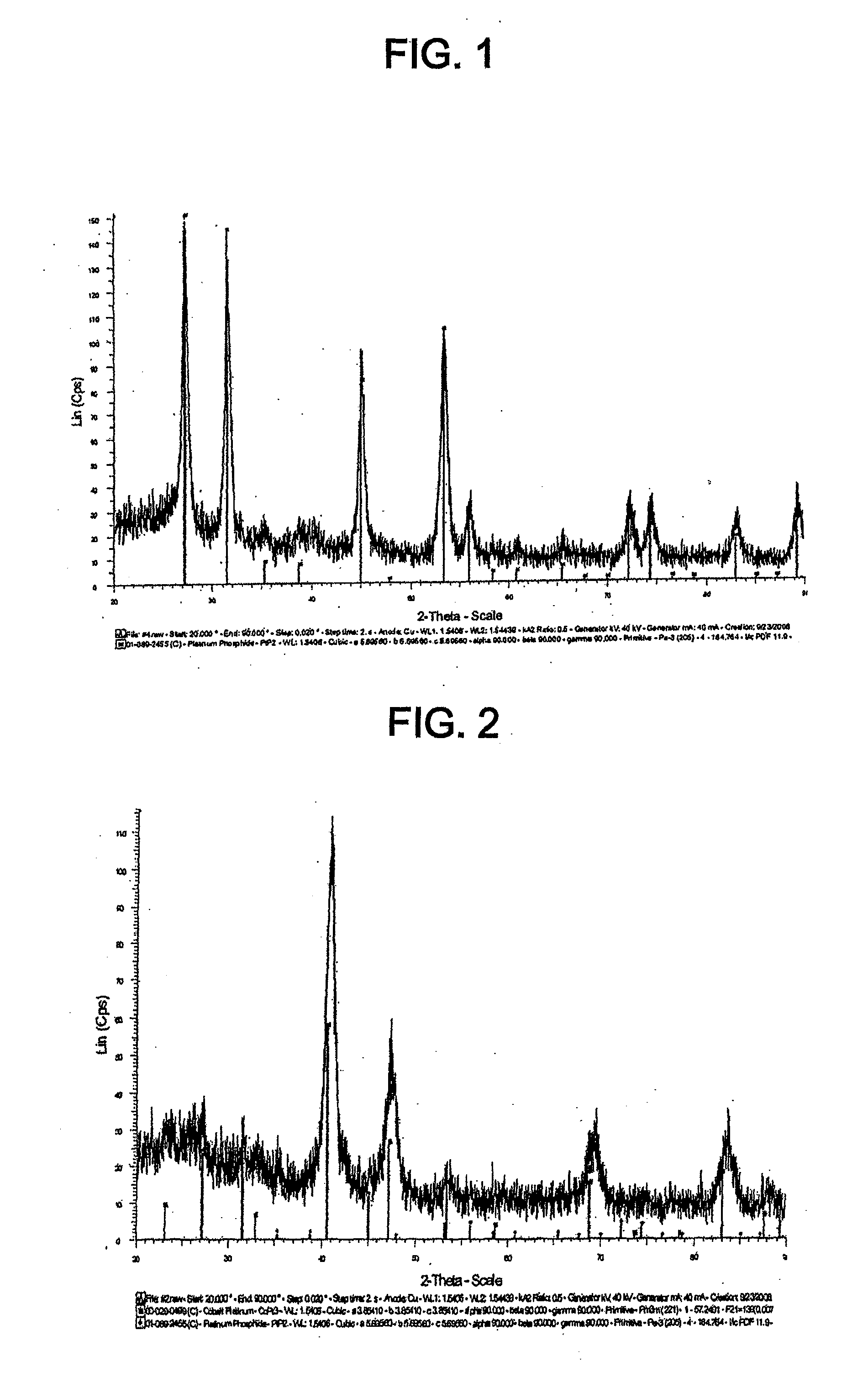
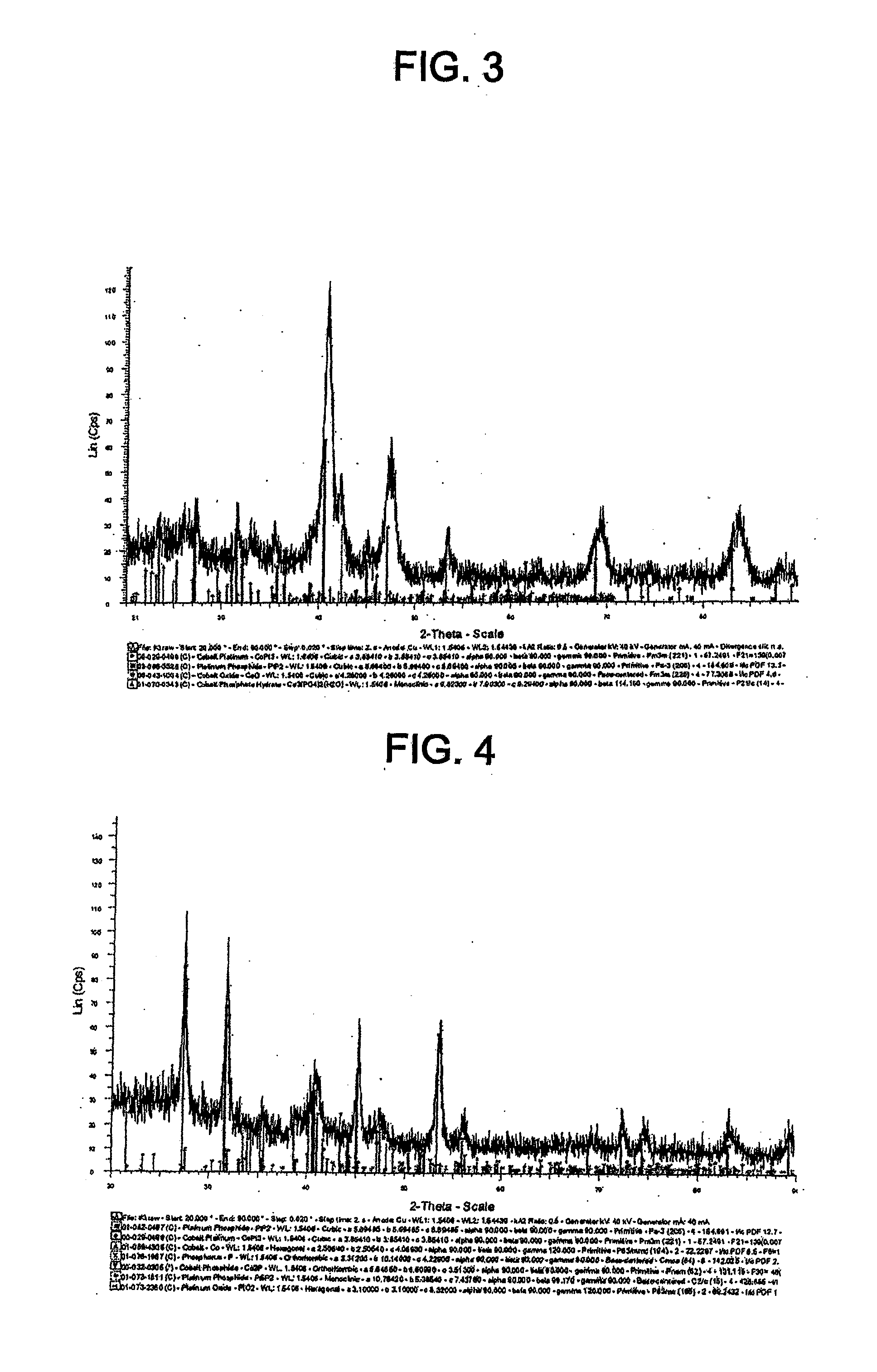
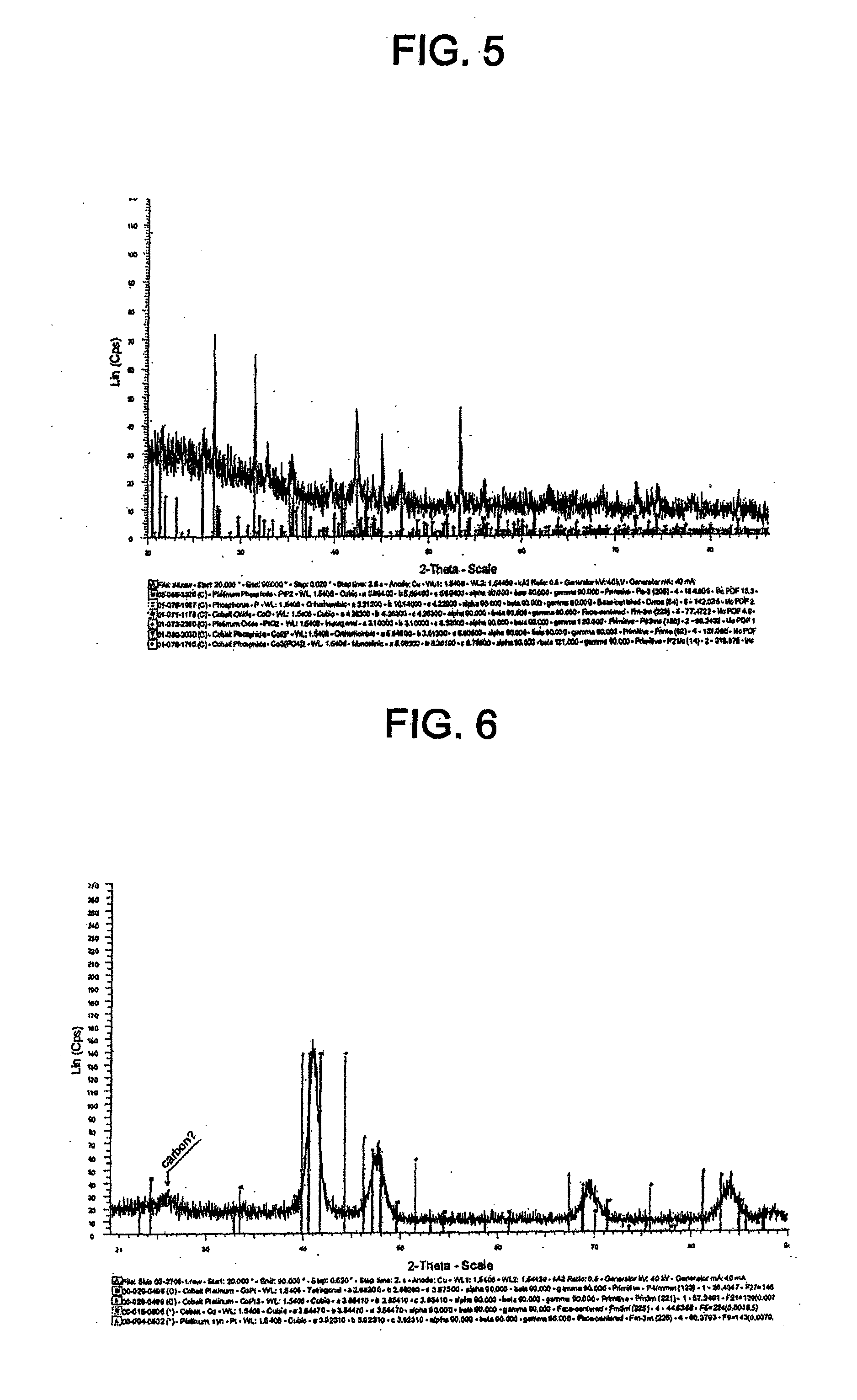
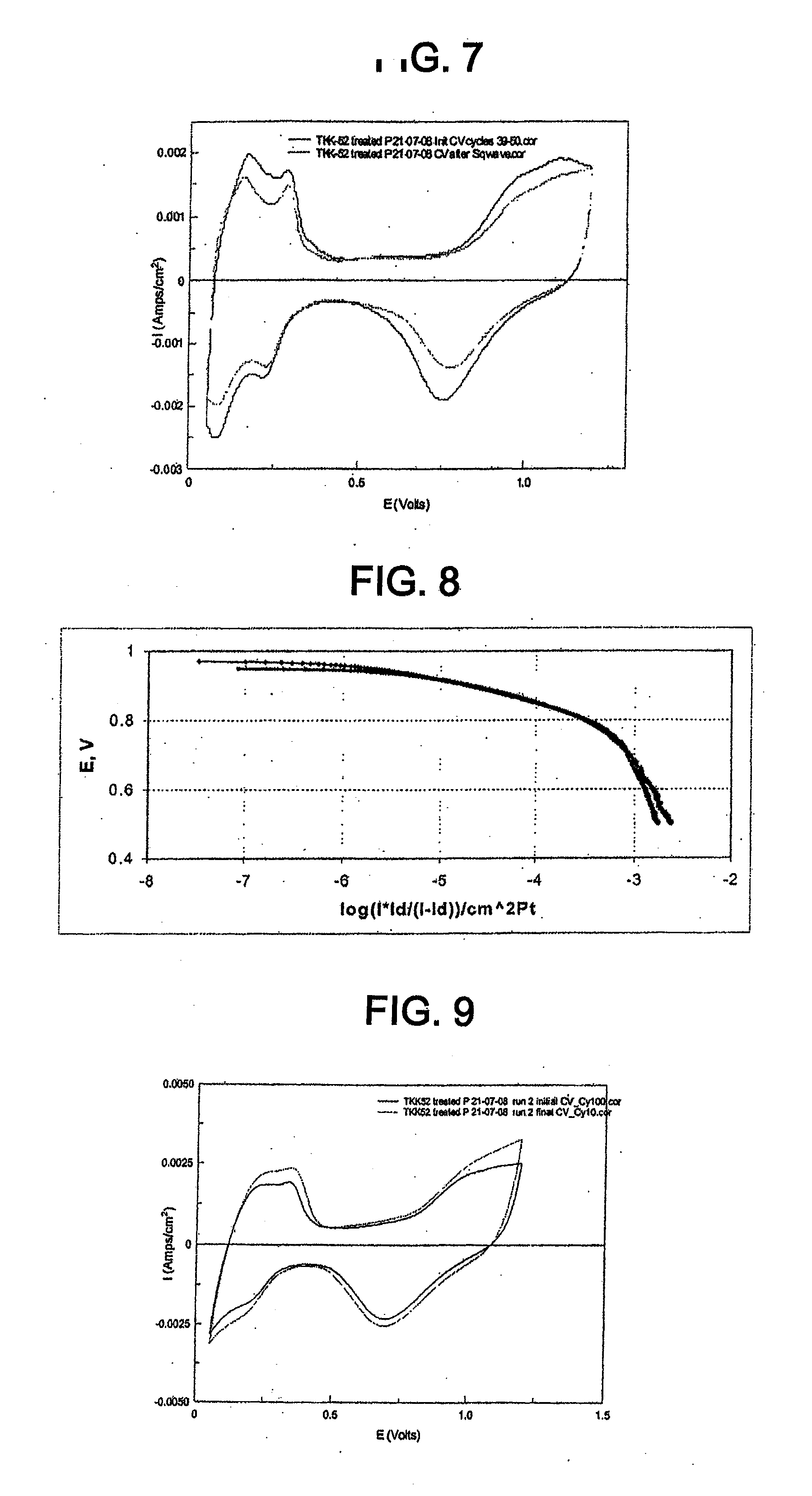
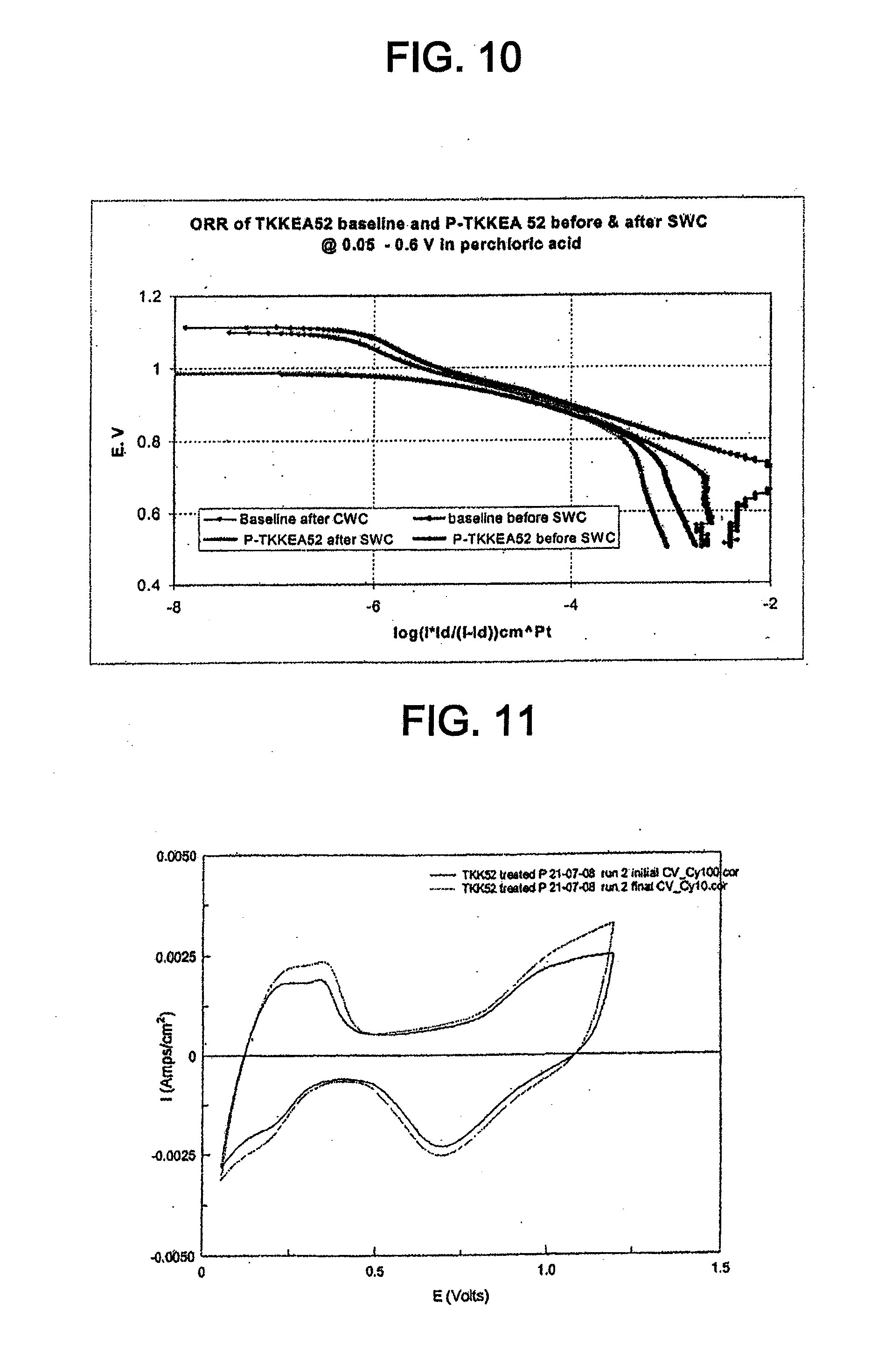
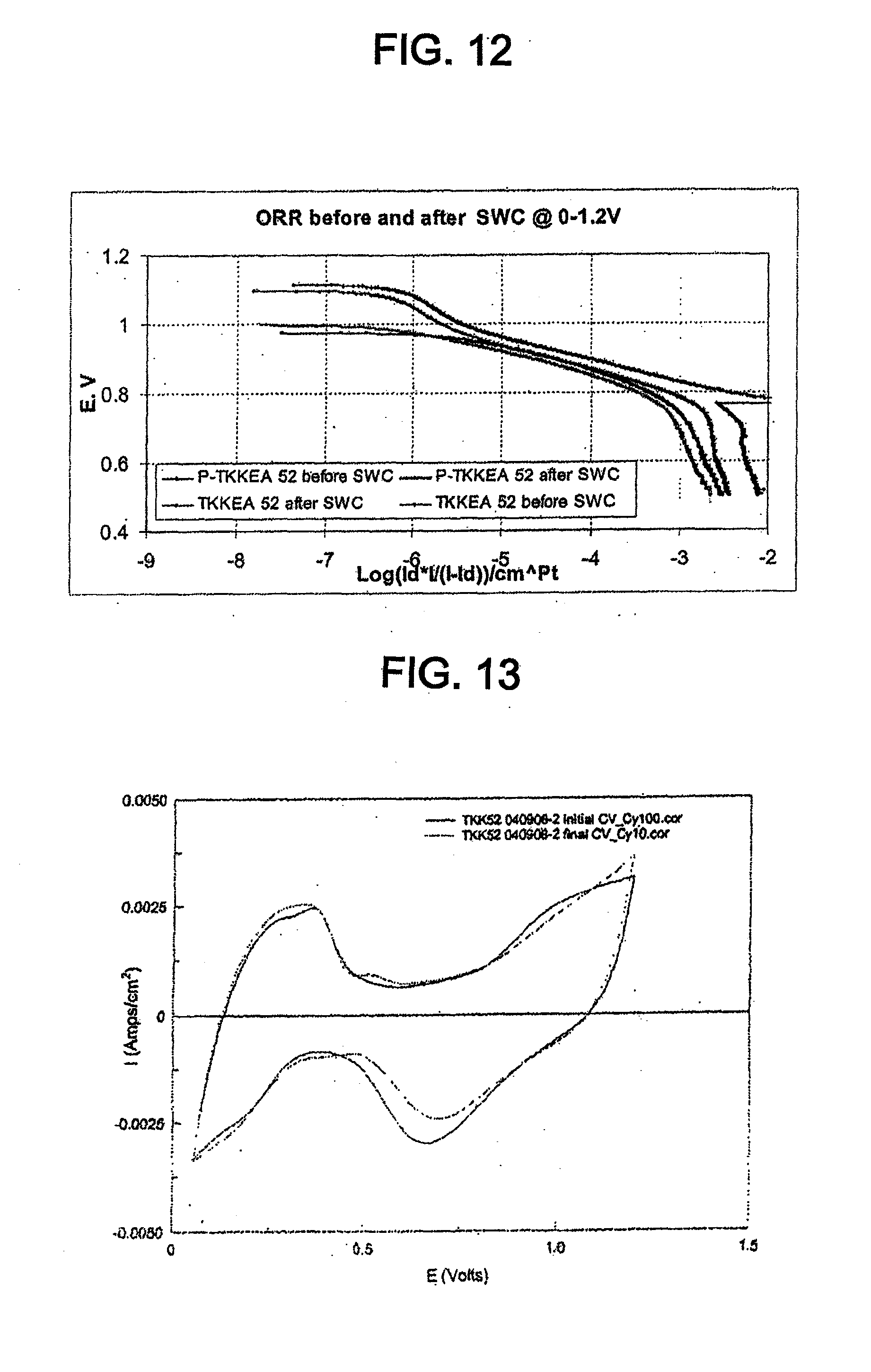
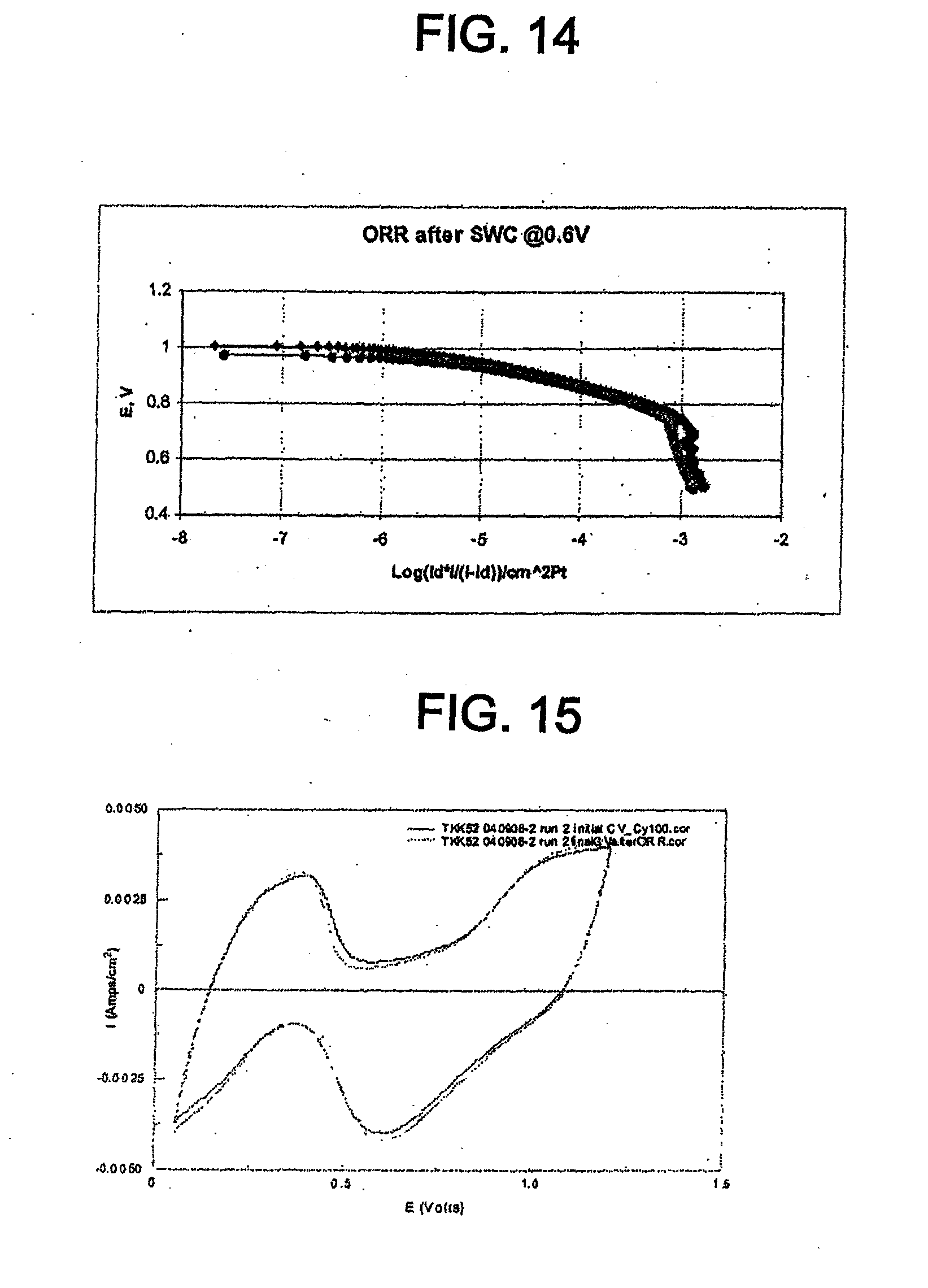
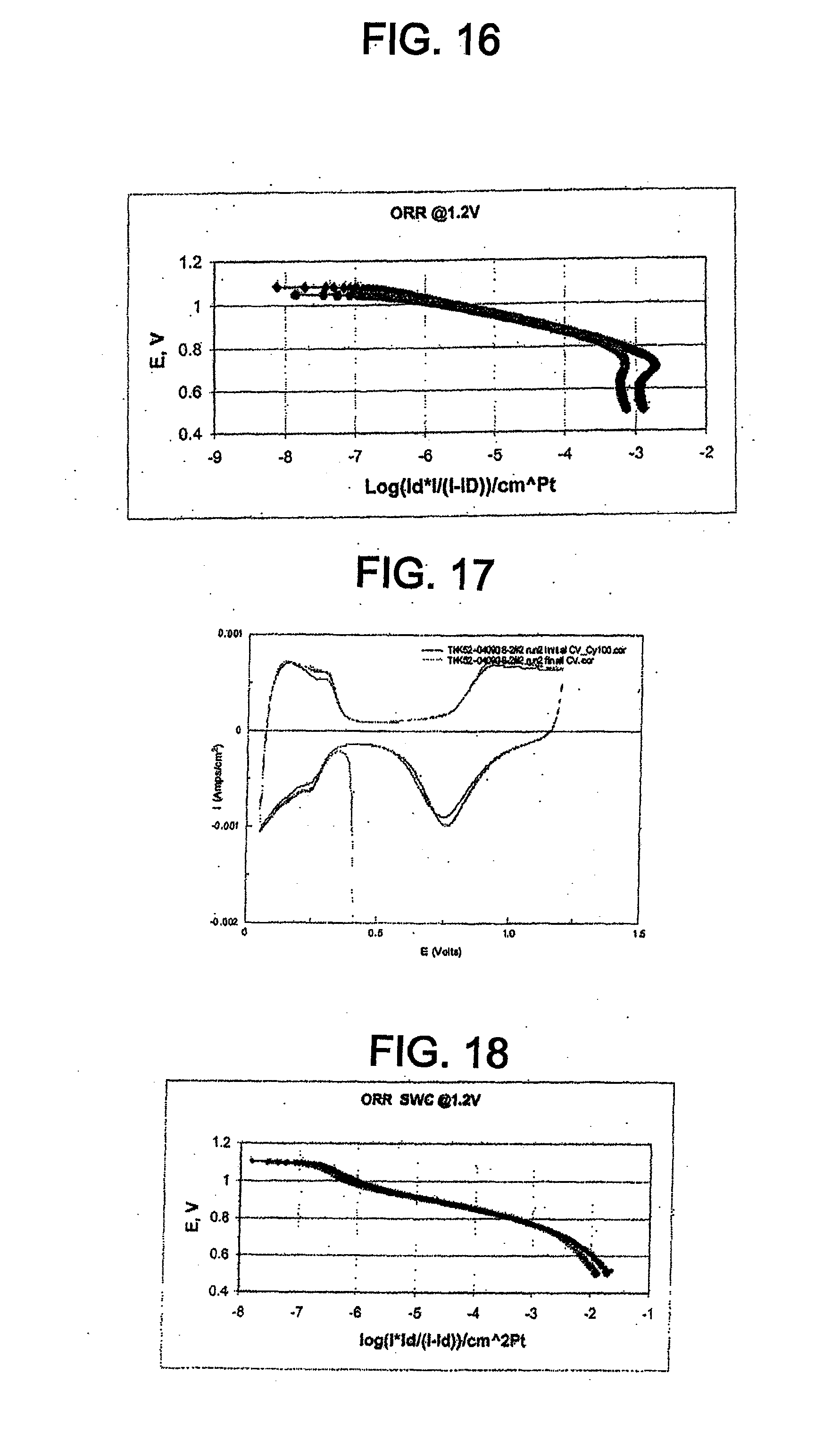
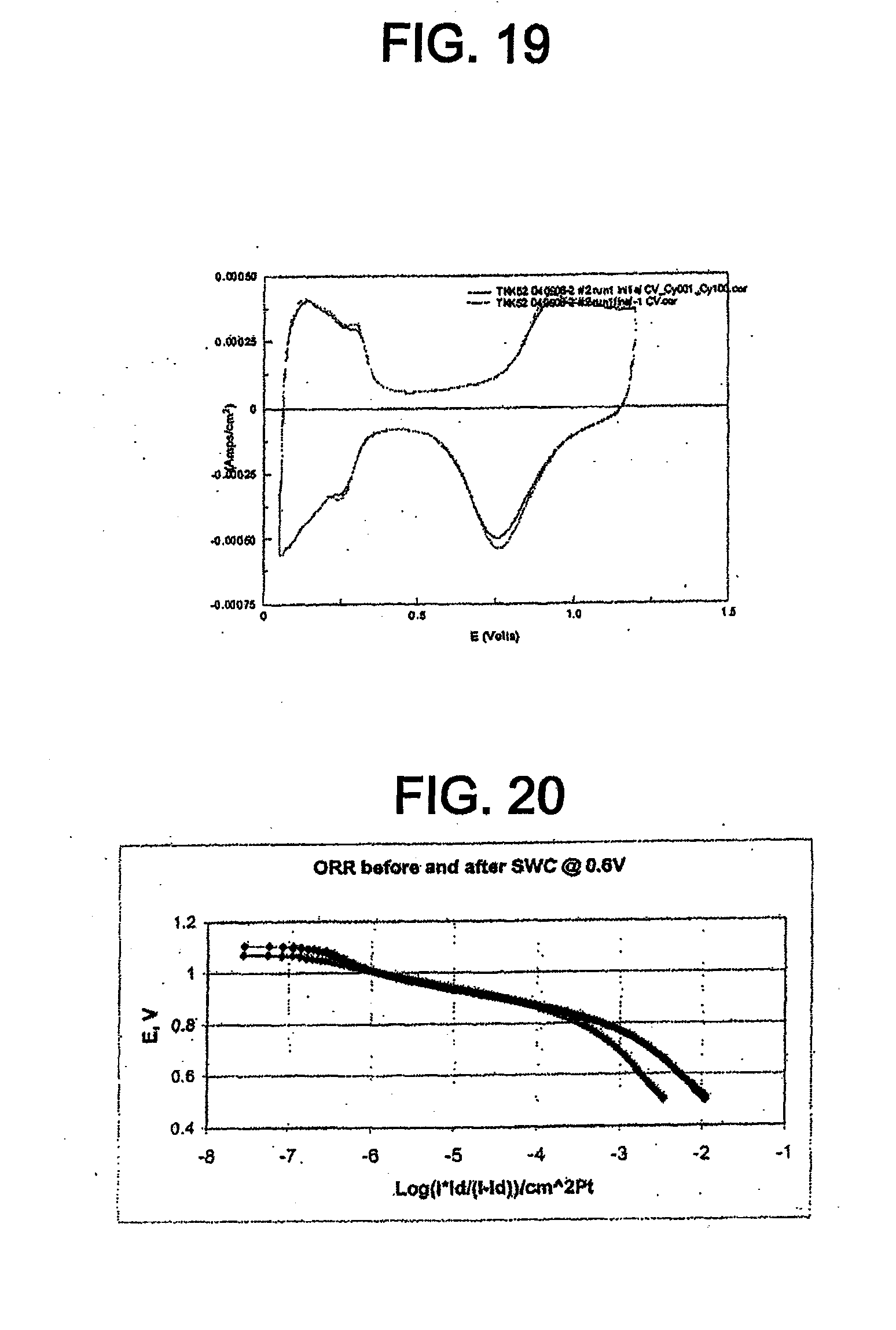

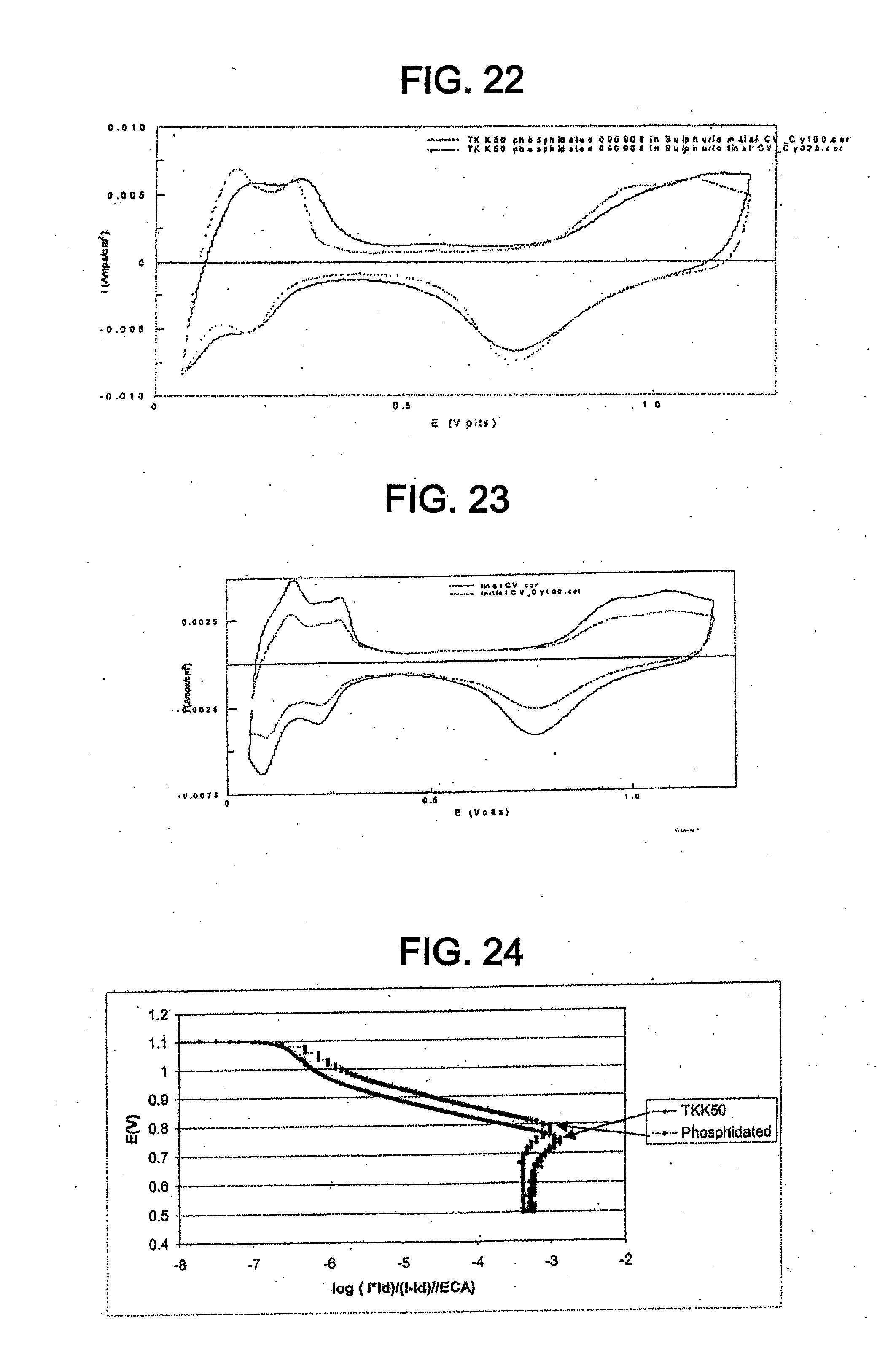
View All Diagrams
| United States Patent Application | 20110318662 |
| Kind Code | A1 |
| Kremliakova; Natalia ; et al. | December 29, 2011 |
PLATINUM PHOSPHIDE AS A CATHODE CATALYST FOR PEMFCS AND PHOSPHOROUS TREATMENT OF CATALYSTS FOR FUEL CELL
Abstract
The present disclosure relates to a catalyst including platinum phosphide having a cubic structure, a method of making the catalyst, and a fuel cell utilizing the catalyst. The present disclosure also relates to method of making electrical power utilizing a PEMFC incorporating the catalyst. Also disclosed herein is a catalyst including a platinum complex wherein platinum is complexed with a nonmetal or metalloid. The catalyst with the platinum complex can exhibit good electro-chemically active properties.
| Inventors: | Kremliakova; Natalia; (Burnaby, CA) ; McDermid; Scott; (Vancouver, CA) ; Campbell; Stephen; (Maple Ridge, CA) |
| Assignee: | FORD MOTOR COMPANY Dearborn MI DAIMLER AG Stuttgart |
| Family ID: | 42728825 |
| Appl. No.: | 13/255293 |
| Filed: | March 12, 2010 |
| PCT Filed: | March 12, 2010 |
| PCT NO: | PCT/US10/27181 |
| 371 Date: | September 8, 2011 |
Related U.S. Patent Documents
| Application Number | Filing Date | Patent Number | ||
|---|---|---|---|---|
| 61159633 | Mar 12, 2009 | |||
| 61159843 | Mar 13, 2009 | |||
| 61159838 | Mar 13, 2009 | |||
| 61159628 | Mar 12, 2009 | |||
| Current U.S. Class: | 429/428 ; 420/466; 423/289; 423/299; 423/409; 423/509; 423/561.1; 429/483; 429/524; 502/180; 502/200; 502/207; 502/213; 502/215; 502/223; 502/339 |
| Current CPC Class: | H01M 4/925 20130101; H01M 4/926 20130101; Y02E 60/50 20130101; H01M 4/921 20130101; H01M 4/923 20130101; H01M 2008/1095 20130101; H01M 4/928 20130101; B01J 27/1856 20130101; H01M 4/8657 20130101 |
| Class at Publication: | 429/428 ; 429/524; 429/483; 423/299; 502/213; 502/180; 502/200; 502/207; 423/561.1; 423/509; 423/289; 423/409; 502/223; 502/215; 502/339; 420/466 |
| International Class: | H01M 4/92 20060101 H01M004/92; H01M 8/04 20060101 H01M008/04; C01B 25/08 20060101 C01B025/08; B01J 27/185 20060101 B01J027/185; B01J 21/18 20060101 B01J021/18; C22C 5/04 20060101 C22C005/04; C01G 55/00 20060101 C01G055/00; C01B 19/04 20060101 C01B019/04; C01B 21/06 20060101 C01B021/06; B01J 27/045 20060101 B01J027/045; B01J 27/057 20060101 B01J027/057; B01J 23/644 20060101 B01J023/644; H01M 8/10 20060101 H01M008/10; B01J 27/24 20060101 B01J027/24 |
Claims
1. A catalyst comprising platinum phosphide having a cubic structure.
2. The catalyst according to claim 1, wherein the platinum phosphide comprises a surface layer on a platinum catalyst core.
3. The catalyst according to claim 2, wherein the platinum catalyst core comprises a Pt-transition metal alloy.
4. The catalyst according to claim 3, wherein the transition metal is selected from the group consisting of Co, Fe, Ni, Cu, and combinations thereof.
5. The catalyst according to claim 1, wherein the platinum phosphide is directly on a support material.
6. The catalyst according to claim 5, wherein the support material is selected from the group consisting of a carbon support material, a metal oxide, a carbide, a nitride, a boride, and combinations thereof.
7. A fuel cell comprising the catalyst of claim 1.
8. The fuel cell according to claim 7, wherein the catalyst is located at a cathode.
9. The fuel cell according to claim 7, wherein the catalyst is located at an anode.
10. The fuel cell according to claim 7, wherein the fuel cell is a proton exchange membrane fuel cell (PEMFC).
11. A method of making electrical power: a. providing hydrogen to an anode of the fuel cell of claim 10; b. reacting the hydrogen at the anode to provide protons and electrons; c. causing the electrons to travel along an external circuit to a cathode of the fuel cell to provide electrical power; d. providing oxygen to the cathode; and e. reacting the protons, electrons, and oxygen at the cathode to provide water.
12. The method of making the catalyst of claim 1, comprising: a. combining a platinum catalyst with a phosphiding agent; and b. heating the platinum catalyst and the phosphiding agent.
13. The method according to claim 12, wherein the phosphiding agent is selected from the group consisting of elemental phosphorous (P), phosphine gas (PH.sub.3), trioctyl phosphine (TOP), phosphides, and combinations thereof.
14. The method according to claim 12, wherein the heating step occurs in a vacuum.
15. The method according to claim 12, wherein the platinum catalyst and the phosphiding agent are heated at a temperature between about 200.degree. C. and about 1000.degree. C. for a time period between about 5 minutes and about 60 minutes.
16. The method according to claim 12, wherein the heating step comprises treating the platinum catalyst and the phosphiding agent with microwave radiation.
17. A catalyst comprising a platinum complex wherein platinum is complexed with a nonmetal or metalloid selected from the group consisting of S, Se, Te, As, Sb, B, N, and combinations thereof.
18. The catalyst according to claim 17, wherein the platinum complex comprises a surface layer on a platinum catalyst core.
19. The catalyst according to claim 17, wherein the platinum complex is directly on a support material.
Description
PRIORITY
[0001] This application claims priority to U.S. Provisional Application Nos. 61/159,633 and 61/159,628, filed Mar. 12, 2009, and 61/159,843 and 61/159,838, filed Mar. 13, 2009. These applications are incorporated by reference in their entireties herein.
FIELD OF ART
[0002] The present disclosure relates to a catalyst comprising platinum phosphide having a cubic structure and a method of making the catalyst. The present disclosure further relates to a fuel cell incorporating the catalyst and a method of making electrical power. Additionally, the present disclosure relates to a catalyst comprising a platinum complex wherein platinum is complexed with a nonmetal or metalloid.
BACKGROUND
[0003] Proton exchange membrane fuel cells (PEMFCs) are a candidate for transport fuel cell applications (e.g. vehicles) as well as stationary fuel cell applications. These fuel cells require active and stable catalysts both at the anode and at the cathode.
[0004] Currently, PEMFCs use platinum catalysts such as carbon-supported platinum and platinum-transition metal alloy catalysts. While current platinum catalysts may be sufficient for application at the anode, the fuel cell industry seeks cathode catalysts having improved stability to dissolution and sustained or improved activity. Improved stability and activity are necessary to compensate for required catalyst loading reductions with increased fuel cell stack volume power density.
[0005] It is known that platinum-transition metal alloy catalysts have enhanced activity for the oxygen reduction reaction (ORR) at the cathode compared to carbon-supported platinum catalysts. However, current platinum catalysts lack sufficient stability in the acidic electrolytes of PEMFCs.
[0006] For example, during operation of a PEMFC, carbon-supported platinum dissolves or agglomerates resulting in electrochemical surface area (ECA) losses thereby decreasing catalyst activity. Similarly, transition metals of the platinum-transition metal alloy catalysts eventually dissolve to a greater extent than platinum. Accordingly, these platinum-transition metal alloy catalysts are eventually no more reactive than simple platinum catalysts.
[0007] Therefore, there is a need for platinum catalysts having improved stability and sustained or improved activity for use in PEMFCs.
SUMMARY
[0008] Disclosed herein is a catalyst comprising platinum phosphide having a cubic structure. Also disclosed herein is a method of making the catalyst. The method comprises combining a platinum catalyst with a phosphiding agent and heating the platinum catalyst and the phosphiding agent.
[0009] Further disclosed herein is a fuel cell comprising the catalyst. Additionally, disclosed herein is method of making electrical power. The method comprises the following steps: providing hydrogen to an anode of a PEMFC comprising the catalyst; reacting the hydrogen at the anode to provide protons and electrons; causing the electrons to travel along an external circuit to a cathode of the fuel cell to provide electrical power; providing oxygen to the cathode; and reacting the protons, electrons, and oxygen at the cathode to provide water.
[0010] Among other factors, the catalyst comprising platinum phosphide having a cubic structure can exhibit enhanced stability to dissolution in an acidic environment, can better maintain its activity in use, and can even exhibit increased activity. These catalysts may be easily synthesized from currently available, commercial platinum catalysts.
[0011] The advantages of the catalyst disclosed herein can impart advantages to a fuel cell utilizing the catalyst. For example, increased catalyst activity can enable lower catalyst loading and decreased fuel cell cost. Increased stability and preserved or improved activity can also reduce or prevent voltage losses and prolong fuel cell life. Furthermore, the catalyst disclosed herein can reduce or prevent damage to fuel cell components caused by, for example, carbon corrosion and radical formation.
[0012] Also disclosed herein is a catalyst comprising a platinum complex wherein platinum is complexed with a nonmetal or metalloid. This catalyst can exhibit good electrochemically active properties (e.g. good activity for the ORR).
BRIEF DESCRIPTION OF THE DRAWINGS
[0013] FIG. 1 shows the XRD spectrum for the catalyst of Example 1.
[0014] FIG. 2 shows the XRD spectrum for the catalyst of Example 2.
[0015] FIG. 3 shows the XRD spectrum for the catalyst of Example 3.
[0016] FIG. 4 shows the XRD spectrum for the catalyst of Example 4.
[0017] FIG. 5 shows the XRD spectrum for the catalyst of Example 5.
[0018] FIG. 6 shows XRD spectrum for TKK 52.
[0019] FIG. 7 shows cyclic voltammograms for the catalyst of Example 4 in 0.5 M sulphuric acid before and after cycling between 0.05 V and 0.6 V.
[0020] FIG. 8 shows Tafel plots for the catalyst of Example 4 in 0.5 M sulphuric acid, normalized to the active Pt surface area, a) before SWC; b) after SWC at 0.05-0.6 V; and c) before and after SWC between 0.05 V and 0.6 V.
[0021] FIG. 9 shows cyclic voltammograms for the catalyst of Example 4 in 0.1 M perchloric acid before and after cycling between 0.05 V and 0.6 V.
[0022] FIG. 10 shows Tafel plots for the catalyst of Example 4 and TKK 52, normalized to the active Pt surface area, in 0.1 M perchloric acid before and after cycling between 0.05 V and 0.6 V.
[0023] FIG. 11 shows cyclic voltammograms for the catalyst of Example 4 in 0.1 M perchloric acid before and after cycling between 0.05 V and 1.2 V.
[0024] FIG. 12 shows Tafel plots for the catalyst of Example 4, normalized to the active Pt surface area, in 0.1 M perchloric acid before and after cycling between 0.05 V and 1.2 V.
[0025] FIG. 13 shows cyclic voltammograms for the catalyst of Example 2 in 0.1 M perchloric acid before and after cycling between 0.05 V and 0.6 V.
[0026] FIG. 14 shows Tafel plots for the catalyst of Example 2, normalized to the active Pt surface area, in 0.1 M perchloric acid before and after cycling between 0.05 V and 0.6 V.
[0027] FIG. 15 shows cyclic voltammograms for the catalyst of Example 2 in 0.1 M perchloric acid before and after cycling between 0.05 V and 1.2 V.
[0028] FIG. 16 shows Tafel plots for the catalyst of Example 2, normalized to the active Pt surface area, in 0.1 M perchloric acid before and after cycling between 0.05 V and 1.2 V.
[0029] FIG. 17 shows cyclic voltammograms for the catalyst of Example 3 in 0.1 M perchloric acid before and after cycling between 0.05 V and 1.2 V.
[0030] FIG. 18 shows Tafel plots for the catalyst of Example 3, normalized to the active Pt surface area, in 0.1 M perchloric acid before and after cycling between 0.05 V and 1.2 V.
[0031] FIG. 19 shows cyclic voltammograms for the catalyst of Example 3 in 0.1 M perchloric acid before and after cycling between 0.05 V and 0.6 V.
[0032] FIG. 20 shows Tafel plots for the catalyst of Example 3, normalized to the active Pt surface area, in 0.1 M perchloric acid before and after cycling between 0.05 V and 0.6 V.
[0033] FIG. 21 shows Tafel plots for the catalyst of Example 3, normalized to the active Pt surface area, a) before SWC; b) after SWC at 0.05-0.6 V; and c) 0.05-1.2 V versus P amount.
[0034] FIG. 22 shows cyclic voltammograms for the catalyst of Example 11 before and after SWC from 0.6-1.2 V, 60 s, 100 cycles.
[0035] FIG. 23 shows cyclic voltammograms for TKK 50 before and after SWC from 0.6-1.2 V, 60 s, 100 cycles.
[0036] FIG. 24 shows initial ORR Tafel plots for TKK 50 and the catalyst of Example 11.
[0037] FIG. 25 shows initial, 24 hour, and 48 hour cyclic voltammograms for TKK 50 at a 1.2 V potential hold.
[0038] FIG. 26 shows initial, 24 hour, 48 hour, 72 hour, and 96 hour cyclic voltammograms for the catalyst of Example 11 at a 1.2 V potential hold.
[0039] FIG. 27 shows the XRD spectrum for the catalyst of Example 11.
[0040] FIG. 28 shows cyclic voltammograms for the catalyst of Example 11 and TKK 50 before and after SWC from 0.05-0.6 V, 30 s, 1000 cycles.
[0041] FIG. 29 shows cyclic voltammograms for the catalyst of Example 11 and TKK 50 before and after SWC from 0.6-1.5 V, 60 s, 100 cycles.
[0042] FIG. 29A shows cyclic voltammograms for the catalyst of Example 11 and TKK 50 before and after SWC from 0.6-1.2 V, 60 s, 100 cycles.
[0043] FIG. 30 shows Tafel plots for the catalyst of Example 11 and TKK 50 before and after SWC from 0.05-0.6 V, 30 s, 1000 cycles.
[0044] FIG. 31 shows Tafel plots for the catalyst of Example 11 and TKK 50 before and after SWC from 0.6-1.2 V, 30 s, 1000 cycles.
[0045] FIG. 32 shows Tafel plots for the catalyst of Example 11 and TKK 50 before and after SWC from 0.6-1.5 V, 60 s, 100 cycles.
[0046] FIG. 33 shows the cubic structure of the platinum phosphide of the catalyst disclosed herein.
[0047] FIG. 34 shows the XRD spectra of the catalyst of Example 15 and TKK 50.
[0048] FIG. 35 shows the XRD spectra of the catalysts of Example 16.
[0049] FIG. 36 shows the average P/Pt mole ratio of the microwave phosphided catalysts of Examples 15 and 16 as determined by EDX.
[0050] FIG. 37 shows the effect of treatment time on final solution temperature for the catalysts of Examples 15 and 16.
DETAILED DESCRIPTION
Definitions and Abbreviations
[0051] The following terms appear throughout the specification and drawings and have the following meanings, unless otherwise indicated.
[0052] "CV" means cyclic voltammogram or cycling voltammetry.
[0053] "ECA" means electrochemical surface area (cm.sup.2/g Pt or m.sup.2/g Pt) determined by adsorbed hydrogen oxidation followed by proton desorption. Increased ECA should correspond to decreased catalyst particle size and higher catalyst mass activity.
[0054] "EDX" means energy-dispersive x-ray spectroscopy.
[0055] "ICP AES" means inductively coupled plasma atomic emission spectroscopy.
[0056] "ICP MS" means inductively coupled plasma mass spectrometry.
[0057] "OCV" means open cell voltage.
[0058] "ORR" means oxygen reduction reaction.
[0059] "PEMFC" means proton exchange membrane fuel cell.
[0060] "RDE" means rotating disk electrode.
[0061] "Stability" refers to stability to dissolution in an acidic environment (e.g. an acidic electrolyte).
[0062] "SWC" means square wave cycling.
[0063] "TKK 50" and "TKKEA50" refer to a catalyst purchased from the Japanese company Tanaka Kikinzoku Kogyo K.K. The catalyst consists of carbon supported Pt and the ratio of Pt:C is 50 wt % Pt:50 wt % C.
[0064] "TKK 52" and "TKKEA52" refer to a catalyst purchased from the Japanese company Tanaka Kikinzoku Kogyo K.K. The catalyst consists of carbon supported Pt.sub.3Co with the ratio of Pt.sub.3Co:C of 52 wt %:48 wt %.
[0065] "TOP" means trioctyl phosphine.
[0066] "XRD" means x-ray diffraction.
Catalyst Including Platinum Phosphide Having a Cubic Structure and its Applications
[0067] The catalyst disclosed herein comprises platinum phosphide (PtP.sub.2) having a cubic structure. In one embodiment, the platinum phosphide comprises a surface layer on a platinum catalyst core. In this embodiment, the platinum catalyst core may comprise a Pt-transition metal alloy. The transition metal may be, for example, Co, Fe, Ni, Cu, or combinations thereof. In one embodiment, the platinum phosphide is directly on a support material. The support material may be, for example, a carbon support material, a metal oxide, a carbide, a nitride, a boride, or combinations thereof.
[0068] The catalyst can have an average particle size between about 1 nm and about 50 nm, for example, between about 2 nm and about 10 nm. A smaller average particle size is desirable because it corresponds to higher electrochemical surface area (ECA) and increased catalyst mass activity.
[0069] In general, platinum phosphide is a thermally and chemically stable compound. It decomposes at 1670 K and withstands boiling in Aqua Regia for more than 24 hours.
[0070] U.S. Pat. No. 3,449,169 ("the '169 patent") discloses the first attempt to synthesize platinum phosphide as an electro catalyst. The '169 patent discloses a novel platinum phosphide fuel cell electrode and a method for preparing "high surface area" platinum phosphide. However, the '169 patent does not define the structure of the platinum phosphide and the catalyst disclosed therein did not exhibit exceptional electrochemical behavior. Since this initial investigation of platinum phosphide in fuel cell catalysis, little attention has been devoted to the use of phosphides (or phosphorous) in fuel cell catalysis and even less attention has been devoted to the use of platinum phosphide.
[0071] The present inventors have surprisingly discovered platinum phosphide having a cubic structure. In the cubic structure, a=b=c may be equal to 5.69 .ANG., while .alpha.=.beta.=.gamma.=90.degree.. FIG. 33 shows the cubic structure of the platinum phosphide of the catalyst disclosed herein. Platinum phosphide having the cubic structure can provide improved catalyst stability to dissolution as well as better sustained or improved catalyst activity. Platinum phosphide having the cubic structure can exhibit activity higher than or comparable to platinum catalysts currently used at anodes and cathodes in PEMFCs. Platinum phosphide having the cubic structure can also reduce or prevent catalyst support corrosion.
[0072] When the platinum phosphide comprises a surface layer on a platinum catalyst core, the phosphide layer can enhance the platinum catalyst core's stability to dissolution in an acidic environment, thus preserving the activity of the platinum catalyst core. For example, the phosphide layer can reduce or prevent dissolution of platinum and transition metals of platinum-transition metal alloy catalysts. The platinum phosphide may even enhance catalyst activity. Without being bound by a particular theory, it is believed that the surface phosphorous present in the cubic structure of the platinum phosphide provides multiple active sites.
[0073] The catalyst disclosed herein is particularly useful in fuel cell applications because it can exhibit better sustained or improved activity for the oxygen reduction reaction (ORR). Fuel cells include an anode and a cathode separated by an electrolyte. At the anode, a catalyst oxidizes a fuel (e.g. hydrogen, natural gas, methanol, diesel, gasoline) to provide positively charged ions and electrons. The positively charged ions then pass through the electrolyte, but the electrons do not. This is because the electrolyte is conductive to the positively charged ions, but non-conductive to the electrons. Instead, the electrons travel through a wire creating an electrical current. This electrical current is the primary product of the fuel cell and can power electrical devices. At the cathode, the positively charged ions, electrons, and an oxidant, usually oxygen, react in the presence of a catalyst to create water as a waste product. Accordingly, an oxidation reaction occurs at the anode and a reduction reaction occurs at the cathode. Since oxygen is typically reduced at the cathode, an oxygen reduction reaction typically occurs at the cathode. Thus, the catalyst disclosed herein is especially useful as a cathode catalyst.
[0074] The catalyst disclosed herein can exhibit electrochemical properties similar to known platinum catalysts useful as anode catalysts. Accordingly, the catalyst disclosed herein may also be used as an anode catalyst.
[0075] Accordingly, a fuel cell may comprise the catalyst disclosed herein. In one embodiment, the catalyst is located at a cathode of the fuel cell. In another embodiment, the catalyst is located at an anode of the fuel cell. In yet another embodiment, the catalyst is located at both the anode and the cathode of the fuel cell.
[0076] In one embodiment, the fuel cell is a proton exchange membrane fuel cell (PEMFC). PEMFCs are well known in the art and have various advantages over other types of fuel cells. PEMFCs utilize a hydrated, solid polymer membrane as the electrolyte separating the anode and the cathode. A solid electrolyte is advantageous over a liquid electrolyte because the solid electrolyte permits less expensive manufacture of the fuel cell, exhibits fewer difficulties with orientation, and exhibits fewer problems with corrosion. Compared to other fuel cells, PEMFCs can generate more power per volume or weight of the fuel cell. They also have a relatively low operating temperature (e.g. less than 100.degree. C.). This low operating temperature permits rapid start-up. PEMFCs also have the ability to rapidly change power output. As a result, PEMFCs are believed to be the best type of fuel cell to replace gasoline and diesel internal combustion engines in vehicles.
[0077] Generally in PEMFCs, the fuel provided to the anode is hydrogen and the reactant provided to the cathode is oxygen in the form of air. Accordingly, the following reactions generally occur in a PEMFC:
Anode reaction: 2H.sub.2.fwdarw.4H++4e-
Cathode reaction: O.sub.2+4H++4e-.fwdarw.2H.sub.2O
Overall cell reaction: 2H.sub.2+O.sub.2.fwdarw.2H.sub.2O
The cathode reaction is an oxygen reduction reaction. However, the fuel of PEMFCs can vary. For example, the fuel can be methanol, ethanol, or formic acid.
[0078] The catalyst can be used in various types of PEMFCs (e.g. PEMFCs consuming hydrogen, PEMFCs consuming methanol, PEMFCs consuming ethanol, PEMFCs consuming formic acid, etc.). While different types of PEMFCs generally utilize slightly different catalysts, the catalyst disclosed herein is useful in various types of PEMFCs because it can exhibit electrochemical properties similar to known platinum catalysts and can exhibit better sustained or increased activity for the ORR.
[0079] The catalyst can be used in other types of fuel cells besides PEMFCs which incorporate the oxygen reduction reaction. For example, the catalyst can be used in a phosphoric acid fuel cell. Again, this is because the catalyst can exhibit electrochemical properties similar to known platinum catalysts and can exhibit better sustained or increased activity for the ORR.
[0080] Fuel cells are capable of providing continuous power. However, in order for a fuel cell to provide continuous power, the reactants (e.g. fuel and oxidant) must flow continuously and the catalysts must remain active. Accordingly, the present catalyst is particularly advantageous because it can exhibit better sustained activity.
[0081] Other than vehicular applications, fuel cells are useful for providing power in various applications where a source of continuous power is important. These applications include base stations and cell sites for wireless communications, emergency power systems, uninterrupted power supplies, and small electronic devices (e.g. notebook computers, portable charging docks, cellular phones, and small heating appliances). Accordingly, the present catalyst may be useful in other applications besides vehicular applications.
[0082] More generally, since the catalyst is useful in fuel cells, it can be used in a method of making electrical power. This method involves providing hydrogen to an anode of a PEMFC comprising the catalyst and reacting the hydrogen at the anode to provide protons and electrons. This method further involves causing the electrons to travel along an external circuit to a cathode of the fuel cell to provide electrical power. This method also involves providing oxygen to the cathode and reacting the protons, electrons, and oxygen at the cathode to provide water.
Method of Making Catalyst Including Platinum Phosphide Having a Cubic Structure
[0083] An advantage of the catalyst disclosed herein is that it can be easily synthesized from currently available, commercial platinum catalysts such as carbon-supported platinum and platinum-transition metal alloy catalysts. The catalyst can be made by combining one of these commercial platinum catalysts (e.g. TKK 50, TKK 52, Johnson Matthey catalysts, E-TEK catalysts) with a phosphiding agent and heating the platinum catalyst and the phosphiding agent. Exemplary phosphiding agents include, but are not limited to, elemental phosphorous (P), phosphine gas (PH.sub.3), trioctyl phosphine (TOP), and phosphides.
[0084] Reaction between the platinum catalyst and the phosphiding agent provides platinum phosphide having a cubic structure. The extent of the reaction during the heating step between the platinum catalyst and the phosphiding agent determines the degree of phosphidation of the platinum catalyst. In other words, the extent of reaction determines whether the platinum phosphide comprises a surface layer on a platinum catalyst core or the platinum phosphide is directly on a support material. The extent of reaction depends on the amount of phosphiding agent, the reaction temperature, and the reaction time. Both types of catalysts can be useful in fuel cell applications. However, partially phosphided catalysts (i.e. catalysts with platinum phosphide comprising a surface layer on a platinum catalyst core) are particularly advantageous over completely phosphided catalysts (i.e. catalysts where the platinum phosphide is directly on a support material) because they can have a smaller particle size and, therefore, increased mass activity. Furthermore, smaller platinum catalyst particles at a given metal loading can provide smaller particles of the catalyst disclosed herein with increased ECA and increased mass activity.
[0085] The heating step may occur in a vacuum. In a vacuum, solid elemental phosphorous converts to the vapor state and reacts with platinum. However, the heating step may occur at different pressures. For example, if PH.sub.3 is used as the phosphiding agent, the heating step may occur at about 1 atm. The platinum catalyst and the phosphiding agent may be heated at between about 200.degree. C. and about 1000.degree. C., for example, between about 450.degree. C. and about 700.degree. C. The platinum catalyst and the phosphiding agent may be heated for a time period of between about 5 min and about 60 min. A fast cooling step may follow the heating step to quench the catalyst and avoid catalytic cluster sintering. During the fast cooling step, the catalyst may be cooled from the reaction temperature to room temperature in between about 5 min and about 10 min. In a particular embodiment, the platinum catalyst and the phosphiding agent are heated at a temperature of about 700.degree. C. for about 1 hour followed by fast cooling. Reducing the reaction time and treating a platinum catalyst with smaller particles can advantageously increase the ECA and the catalyst mass activity.
[0086] In one embodiment, the heating step can involve treating the platinum catalyst and the phosphiding agent with microwave radiation. Using microwave radiation is advantageous because it can decrease the catalyst particle size, thereby increasing the catalyst mass activity. For example, heating the platinum catalyst and the phosphiding catalyst without microwave radiation can produce a platinum phosphide catalyst having high surface activity (e.g. approximately 1.5-2 times that of platinum), but significant particle size growth occurs (e.g. between 3 nm and 7 nm or even greater than 7 nm). In contrast, heating with microwave radiation can significantly reduce particle size growth and provide a catalyst having a smaller average particle size.
[0087] The microwave power can be between about 800 W and about 1100 W, for example, between about 1000 W and about 1100W. In one embodiment, the microwave power can be above about 1000 W. Higher microwave power can advantageously provide a higher reaction temperature, a faster phosphiding reaction, a smaller catalyst particle size, and increased catalyst mass activity.
[0088] The microwave radiation treatment may be conducted under ambient pressure.
Catalyst Including Platinum Complex
[0089] As discussed above, reaction of a platinum catalyst with phosphorous provides an electrochemically active platinum phosphide catalyst. Other nonmetals or metalloids besides P can also be useful. Such nonmetals or metalloids include, but are not limited to, S, Se, Te, As, Sb, B, N, and combinations thereof. Reaction of a platinum catalyst with another nonmetal or metalloid can provide a catalyst comprising a platinum complex wherein platinum is complexed with the nonmetal or metalloid. The catalyst comprising the platinum complex exhibits good electrochemically active properties (e.g. good activity for the ORR).
[0090] Accordingly, also disclosed herein is a catalyst comprising a platinum complex wherein platinum is complexed with a nonmetal or metalloid. In particular, the nonmetal or metalloid may be selected from the group consisting of S, Se, Te, As, Sb, B, N, and combinations thereof. Like platinum phosphide having a cubic structure, the platinum complex can comprise a surface layer on a platinum catalyst core or can be directly on a support material.
[0091] The discussion above regarding the catalyst comprising platinum phosphide having a cubic structure can also apply to the catalyst comprising platinum complexed with another nonmetal or metalloid. For example, the catalyst comprising the platinum complex may be utilized in a fuel cell, such as a PEMFC, and may be used in the above-described method of making electrical power. As another example, the catalyst comprising the platinum complex may utilize the same support materials and have the same platinum catalyst core. As yet another example, the catalyst comprising the platinum complex may be made by the same methods discussed above with the exception that an appropriate nonmetal or metalloid (e.g. S) or an appropriate compound comprising the nonmetal or metalloid (e.g. hydrogen sulfide) is substituted for the phosphiding agent. From the discussion above regarding the catalyst comprising platinum phosphide having a cubic structure, its applications, and its method of making in combination with knowledge in the art, one of ordinary skill in the art would understand how to make and use the catalyst comprising the platinum complex.
[0092] The following examples are provided to further illustrate the present invention and the advantages thereof. The examples are meant to be only illustrative, and not limiting.
EXAMPLES
Example 1
Synthesis of Platinum Phosphide Catalyst Using TKK 50 and P
[0093] A weighted amount of Phosphorous Red (Puratronic 99.999%) was combined with a weighted amount of TKK 50 in an atomic ratio of Pt:P=1:2 in a quartz ampoule. The ampoule was vacuumed (to 10.sup.-5 Torr) and sealed by CANSCI Glass Production, Burnaby. The sample was then heated at 700.degree. C. for 1 hour followed by fast cooling.
Example 2
Synthesis of Catalyst With Platinum Phosphide Surface Layer Using TKK 52 and P
[0094] A weighted amount of Phosphorous Red (Puratronic 99.999%) was combined with a weighted amount of TKK 52 in an atomic ratio of P:Co=1:1 in a quartz ampoule. The ampoule was vacuumed (to 10.sup.-5 Ton) and sealed by CANSCI Glass Production, Burnaby. The sample was then heated at 700.degree. C. for 1 hour followed by fast cooling.
Example 3
Synthesis of Catalyst With Platinum Phosphide Surface Layer Using TKK 52 and P
[0095] A weighted amount of Phosphorous Red (Puratronic 99.999%) was combined with a weighted amount of TKK 52 in an atomic ratio of P:Co=1:2 in a quartz ampoule. The ampoule was vacuumed (to 10.sup.-5 Ton) and sealed by CANSCI Glass Production, Burnaby. The sample was then heated at 700.degree. C. for 1 hour followed by fast cooling.
Example 4
Synthesis of Catalyst With Platinum Phosphide Surface Layer Using TKK 52 and P
[0096] A weighted amount of Phosphorous Red (Puratronic 99.999%) was combined with a weighted amount of TKK 52 in a non-stoichiometric excess of P relative to Co in a quartz ampoule. The ampoule was vacuumed (to 10.sup.-5 Ton) and sealed by CANSCI Glass Production, Burnaby. The sample was then heated at 700.degree. C. for 1 hour followed by fast cooling.
Example 5
Synthesis of Catalyst With Platinum Phosphide Surface Layer Using PtCo and P
[0097] A weighted amount of Phosphorous Red (Puratronic 99.999%) was combined with a weighted amount of PtCo in a ratio of Pt:Co:P=1:1:1 in a quartz ampoule. The ampoule was vacuumed (to 10.sup.-5 Ton) and sealed by CANSCI Glass Production, Burnaby. The sample was then heated at 700.degree. C. for 1 hour followed by fast cooling.
Example 6
Crystalline Structures
[0098] To determine the crystalline structures of the catalysts of Examples 1-5, the catalysts were subjected to XRD. FIGS. 1-5 show the XRD spectra for the catalysts of Examples 1-5. TKK 52 was also subjected to XRD. FIG. 6 shows the XRD spectra for TKK 52.
[0099] Table 1 shows the phase compositions and lattice parameters of TKK 50, TKK 52, and the catalysts of Examples 1-5. The catalysts of Examples 1-5 show the presence of the PtP.sub.2 cubic phase.
[0100] In Examples 2-5, the PtCo alloy is sacrificed to form the PtP.sub.2 cubic phase. None of the catalysts of Examples 2-5 include a PtCo tetragonal phase. As the P content increases, the fraction of PtP.sub.2 increases and the fraction of PtCo alloy decreases. See FIG. 4. All Pt transforms to the PtP.sub.2 phase. See FIG. 5. The lowest stoichiometrical Co.sub.2P phase is hardly found when PtCo ordered alloy with tetragonal structure was treated with phosphorous with the atomic ratio Pt.dbd.Co.dbd.P sufficient to produce the CoP.sub.x phase. This means that it is impossible to stabilize Co by converting it to the phosphide form in the presence of Pt.
TABLE-US-00001 TABLE 1 Lattice parameters Particle size Catalyst Precursor Phase (.ANG.) (nm) TKK 50 N/A Pt cubic 3.92400 2.5-3 TKK 52 N/A PtCo tetragonal 2.68200, 2.68200 ~6.02 3.67500 Pt.sub.3Co cubic 3.85410 Example 1: TKK 50 PtP.sub.2 cubic 5.69560 ~10 carbon supported Pt phosphide Example 2: TKK 52 Pt.sub.3Co cubic 3.85410 ~6.1 carbon PtP.sub.2 cubic 5.69560 supported PtCo phosphide Example 3: TKK 52 Pt.sub.3Co cubic 3.85410 ~7.7 carbon PtP.sub.2 cubic 5.69560 supported CoO cubic 4.26000 PtCo Co.sub.3(PO.sub.4).sub.2*H.sub.2O 9.52300, 7.90300, phosphide monoclinic 9.29400 Example 4: TKK 52 PtP.sub.2 cubic 5.68560 ~4.4 carbon Pt.sub.3Co cubic 3.85410 supported Co hexagonal a, b-2.50540, c- phosphide 4.08930 P orthorhombic a-3.31200, b- 10.14000, c-4.22900 Co.sub.2P orthorhombic a-5.64650, b- 6.60990, c-3.51300 Pt.sub.3P.sub.2 monoclinic a-10.76420, b- 5.38540, c-7.43780 PtO.sub.2 hexagonal a, b-3.10000, c- 8.32000 Example 5: Pt Co black, PtP.sub.2 cubic 5.69400 Loss of PtCo very P orthorhombic a-3.31200, b- magnetic phosphide magnetic 10.14000, c- properties 4.22900 CoO cubic 4.26300 PtO.sub.2 hexagonal a, b-3.10000, c- 8.32000 Co.sub.2P orthorhombic a-5.64600, c-6.60800 c-3.51300 Co.sub.3(PO.sub.4).sub.2 monoclinic a-5.06300, c- 8.36100, c- 8.78800
Example 7
Chemical Stability in Acidic Environment
[0101] The catalysts were treated with 0.1M sulphuric acid at 80.degree. C. for 48 hours. The ratio of acid to catalyst was .about.75. To determine Co and Pt content in the acid, decants of the acid were subjected to ICP AES analyses. Table 2 provides the Pt, Co, and P lost to solution for TKK 52 and the catalysts of Examples 1-3. The Co dissolved is Co from the PtCo phase sacrificed to form PtP.sub.2.
TABLE-US-00002 TABLE 2 P Co dissolved Pt dissolved (mg/L) Atomic dissolved (mg/L) (total, mg) Co/P in Catalyst (mg/L) (%) (%) solution Comments TKK 52 0.12 57 Pt.sub.2.4Co = 2/3(Pt.sub.3Co) + 1/3PtCo 7.25% Example 2 <0.10 244 167 1.46 CoP*Co.sub.2P = Co.sub.1.5P 31% 1.2525 2.66% Example 3 <0.10 278 180 1.54 35.3% 1.35 2.87% Example 1 <0.10 194 1.455 mg in 7.5 g of 1.455 solution 3%
[0102] Table 2 shows that phosphidation in vacuum completely protects Pt from dissolution in strong acid media.
[0103] As shown in Table 1, the PtCo phase does not exist at all in phosphided samples of the TKK 52 catalyst. Without being bound by any particular theory, it is believed that the first "PtCo" phase which makes up approximately one third (by molar) of the total Pt.sub.xCo phase is sacrificed to produce PtP.sub.2 and Co is expelled. Table 2 confirms this theory as the catalysts of Examples 2 and 3 leached approximately 1/3 of their total Co. Without being bound by any particular theory, it is believed that platinum phosphide covers the Pt.sub.3Co crystallites as a protective layer preventing the Pt.sub.3Co phase from expelling further Co. This theory is indirectly proven by the initial Pt:Co ratio of TKK 52 being equal to 2.4:1, which corresponds to 2/3 Pt.sub.3Co+1/3 PtCo.
Examples 8-10
Electrochemical Evaluation
[0104] For electrochemical evaluation, catalysts in acid, a Princeton Applied Research Potentiostat/Galvanostat 263A and a Pine Research Inst. Rotating Disk Electrode (RDE) were used. A standard hydrogen electrode was used as the voltage reference. From 20 to 40 mg of catalyst was sonicated for 10 min in 2 mL of glacial acetic acid. 5-15 .mu.L of the prepared inks were deposited on the RDE and covered with 5 .mu.L of 1050 equivalent weight Nafion dispersion in 2-propanol/water solution.
[0105] The catalysts of Examples 2-4 were tested according to the following protocol: [0106] 1. CV in the 0.05-1.2 V range at .omega.=100 mV/sec, 1 mA, nitrogen bubbling, .about.3-10 cycles to determine ECA. If necessary, the catalyst was activated using CV for up to 100 cycles (until constant pattern) at the same conditions. [0107] 2. Potentiodynamic scanning from 0.1 V versus OCV to 0.2 V versus "Reference" at .omega.=2 mV/sec to determine catalyst activity towards ORR at oxygen bubbling. [0108] 3. SWC for 100 cycles at 0.05 V and 0.6 V for 30 sec for each voltage in nitrogen (durability and stability test) [0109] 4. CV cycling to determine Pt ECA after SWC at nitrogen bubbling. [0110] 5. Potentiodynamic scanning from 0.1 V versus OCV to 0.2 V versus "Reference" at .omega.=2 mV/sec after SWC at oxygen bubbling.
Example 8
RDE Analysis of the Catalyst of Example 4
[0111] FIG. 7 shows cyclic voltammograms for the catalyst of Example 4 in 0.5 M sulphuric acid before and after cycling between 0.05 V and 0.6 V.
[0112] FIG. 8 shows Tafel plot for the catalyst of Example 4 in 0.5 M sulphuric acid, normalized to the active Pt surface area, a) before SWC; b) after SWC at 0.05-0.6 V; and c) before and after SWC between 0.05 V and 0.6 V.
[0113] FIG. 9 shows cyclic voltammograms for the catalyst of Example 4 in 0.1 M perchloric acid before and after cycling between 0.05 V and 0.6 V.
[0114] FIG. 10 shows Tafel plots for the catalyst of Example 4 and TKK 52 normalized to the active Pt surface area in 0.1 M perchloric acid before and after cycling between 0.05 V and 0.6 V.
[0115] FIG. 11 shows cyclic voltammograms for the catalyst of Example 4 in 0.1 M perchloric acid before and after cycling between 0.05 V and 1.2 V.
[0116] FIG. 12 shows Tafel plots for the catalyst of Example 4, normalized to the active Pt surface area, in 0.1 M perchloric acid before and after cycling between 0.05 V and 1.2 V.
[0117] Table 3 shows change in ECA and activity before and after SWC for the catalyst of Example 4.
TABLE-US-00003 TABLE 3 Cycling range 0.05-0.6 V Cycling range 0.05-1.2 V In 0.5M sulfuric acid In 0.1M perchloric acid in 0.1M perchloric acid A/g A/g A/g A/g A/g A/g ECA catalyst catalyst ECA catalyst catalyst ECA catalyst catalyst change before after change before after change before after % SWC SWC % SWC SWC % SWC SWC Catalyst of -21.13 1.475 1.227 23.9 3.053 3.41 31.77 2.52 1.91 Example 4 TKK 52 47.2 28.47 5.32 4.91 39.0 3.275 2.3
[0118] The present inventors previously determined that cycling TKK 52 in the region where Co preferably leached out (0.05-0.6 V) resulted in increase of the active Pt surface area followed by decrease in the ORR activity. However, cycling the catalyst of Example 4 between 0.05 and 0.6 V decreased the active platinum surface area by 21.13% and did not change the catalyst activity significantly.
[0119] Although the catalyst of Example 4 demonstrated a slightly decreased activity in perchloric acid in comparison with TKK 52, it demonstrated higher activity after SWC at 0.05-0.6 V. Potential cycling in perchloric acid in both voltage regions resulted in an increase of active platinum surface area with almost unchanged ORR activity.
Example 9
RDE Analysis of the Catalyst of Example 2
[0120] FIG. 13 shows cyclic voltammograms for the catalyst of Example 2 in 0.1 M perchloric acid before and after cycling between 0.05 V and 0.6 V.
[0121] FIG. 14 shows Tafel plots for the catalyst of Example 2, normalized to the active Pt surface area, in 0.1 M perchloric acid before and after cycling between 0.05 V and 0.6 V.
[0122] FIG. 15 shows cyclic voltammograms for the catalyst of Example 2 in 0.1 M perchloric acid before and after cycling between 0.05 V and 1.2 V.
[0123] FIG. 16 shows Tafel plots for the catalyst of Example 2, normalized to the active Pt surface area, in 0.1 M perchloric acid before and after cycling between 0.05 V and 1.2 V.
[0124] Table 4 shows change in ECA and activity before and after SWC for the catalyst of Example 2. As shown in Table 4, the catalyst of Example 2 exhibited a smaller ECA change and decreased performance losses after SWC (a 5.5% decrease in catalyst mass activity compared to a 29.8% decrease in catalyst mass activity for TKK 52).
TABLE-US-00004 TABLE 4 Cycling range 0.05-1.2 V in 0.1M perchloric acid ECA A/g catalyst A/g catalyst change % before SWC after SWC Catalyst of 8.6 4.7 4.44 Example 2 TKK 52 39.0 3.275 2.3
Example 10
RDE Analysis of the Catalyst of Example 3
[0125] FIG. 17 shows cyclic voltammograms for the catalyst of Example 3 in 0.1 M perchloric acid before and after cycling between 0.05 V and 1.2 V.
[0126] FIG. 18 shows Tafel plots for the catalyst of Example 3, normalized to the active Pt surface area, in 0.1 M perchloric acid before and after cycling between 0.05 V and 1.2 V.
[0127] FIG. 19 shows cyclic voltammograms for the catalyst of Example 3 in 0.1 M perchloric acid before and after cycling between 0.05 V and 0.6 V.
[0128] FIG. 20 shows Tafel plots for the catalyst of Example 3, normalized to the active Pt surface area, in 0.1 M perchloric acid before and after cycling between 0.05 V and 0.6 V.
[0129] Table 5 shows change in ECA and activity before and after SWC for the catalyst of Example 3. As shown in Table 5, although the catalyst of Example 3 exhibited lower absolute performance, this can be attributed to the imperfection of the experiment. Importantly, the catalyst of Example 3 exhibited smaller ECA changes and decreased performance losses after SWC compared to TKK 52.
TABLE-US-00005 TABLE 5 Cycling range 0.05-0.6 V Cycling range 0.05-1.2 V in 0.1M perchloric acid in 0.1M perchloric acid A/g A/g A/g A/g ECA catalyst catalyst ECA catalyst catalyst change before after change before after % SWC SWC % SWC SWC Catalyst of 9.65 0.73 0.78 3.75 0.7 0.726 Example 3 TKK 52 28.47 5.32 4.91 39.0 3.275 2.3
[0130] FIG. 21 shows Tafel plots of TKK 52 and the catalysts of Examples 2-4, normalized to the active Pt surface area, a) before SWC; b) after SWC at 0.05-0.6 V; and c) after SWC at 0.05-1.2 V. FIG. 21 shows that ORR activity remained almost the same after SWC in both voltage regions for the catalysts of Examples 2-4, while ORR activity of TKK 52 decreased. Thus, the PtP.sub.2 phase having its own ORR activity forms a stabilizing and protective layer for Pt.sub.3Co crystallites.
[0131] Examples 8-10 show that the ORR activity does not depend on P:Co ratio. Examples 8-10 also show that the initial ORR activities and mass activities of the catalysts of Examples 2-4 are comparable to or even better than the initial ORR activity and mass activity of TKK 52. The best results were obtained for the catalyst of Example 2 (P:Co=1:1).
Example 11
Synthesis of Platinum Phosphide Catalyst Using TKK 50 and P
[0132] A weighted amount of Phosphorous Red (Puratronic, 99.999%) was combined with a weighted amount of TKK 50 in an atomic ratio of Pt:P=1:2 in a quartz ampoule. The ampoule was vacuumed (to 10.sup.-5 Ton) and sealed by CANSCI Glass Production, Burnaby. The sample was heated at 700.degree. C. for 1 hour followed by fast cooling.
Example 12
Crystalline Structure
[0133] To determine the crystalline structure of the catalyst of Example 11, the catalyst was subjected to XRD. FIG. 27 shows the XRD spectrum for the catalyst of Example 11.
Example 13
Chemical Stability in Acidic Environment
[0134] The catalyst of Example 11 and TKK 50 were each treated with 0.1M sulphuric acid at 80.degree. C. for 48 hours. ICP-MS analysis showed no Pt loss (supernatant showed <0.1 mg/L Pt) for the catalyst of Example 11. However, ICP-MS analysis showed a 0.59% loss of total Pt for TKK 50.
Example 14
Electrochemical Evaluation
[0135] For electrochemical evaluation, catalysts in 0.5M H.sub.2SO.sub.4 electrolyte at 30.degree. C., a Princeton Applied Research Potentiostat/Galvanostat 263A and a Pine Research Inst. RDE were used. A standard hydrogen electrode was used as the voltage reference. The electrode rotation speed was 2000 rpm.
[0136] 0.0221 g of the catalyst of Example 11 was transferred to a 5 mL sample vial. 2.0 mL of glacial acetic acid was then volumetrically transferred to the sample vial. The sample was sonicated at room temperature for approximately 10 minutes. 5 .mu.L of the sonicated sample was pipetted onto the RDE and the solvent was allowed to evaporate under a desktop halogen lamp. 5 .mu.L of the sample was applied to the RDE three times. After the solvent evaporated, 5 .mu.L of a Nafion solution (0.5 mL of a 5% Nafion solution diluted in 5 mL of 2-propanol) was applied to the RDE. As a baseline reference, 0.0203 g of TKK 50 was subjected to the procedure described above. Table 6 describes loading of the catalysts onto the RDE.
TABLE-US-00006 TABLE 6 Mass Catalyst Concentration Volume RDE catalyst Sample (mg) (mg/.mu.L) (.mu.L) loading (mg) Catalyst of 22.1 1.105 .times. 10.sup.-2 15 0.166 Example 11 TKK 50 20.3 1.015 .times. 10.sup.-2 15 0.152
[0137] For each catalyst, the electrode was installed and testing initiated. The electrode was subjected to an initial CV cycling from 0.05-1.2 V at 100 mV/s for 100 cycles under N.sub.2. Upon completion of initial CV cycling, the electrolyte was saturated with O.sub.2. The electrode was subjected to an initial ORR with a potential of 0.1 V with respect to OCV and 0.2 V with respect to the reference hydrogen electrode. After ORR, the electrolyte was saturated with N.sub.2 and the electrode was subjected to SWC. Each cycle of SWC held an initial voltage of 0.05 V for 30 seconds and then switched to 0.6 V for 30 seconds. This was repeated for a total of 1000 cycles. Upon completion of SWC, the electrode was subjected to a final 10 cycle CV and a final ORR under the same conditions as the initial CV and the initial ORR. This procedure was repeated for three additional SWC ranges (0.6-0.9 V, 1000 cycles, 30 seconds; 0.6-1.2 V, 100 cycles, 60 seconds; and 0.6-1.5 V, 100 cycles, 60 seconds). In a potentiostatic experiment, an electrode loaded with 15 .mu.L of catalyst was subjected to a 100 cycle CV from 0.05 to 1.2 V at 100 mV/s. The catalyst was then subjected to a static potential of 1.2 V until failure or for 200 hours. At 24 hour intervals, the electrode was subjected to a 10 cycle CV and the electrolyte level was maintained with 18.2 inn water. Table 7 provides a summary of these experiments.
TABLE-US-00007 TABLE 7 Sweep Electrolyte Number Rate/Hold Saturation of Name Conditions Time Gas Cycles 1 Initial CV 0.05-1.2 V 100 mV/S N.sub.2 100 2 Initial ORR 0.1 vs. OCV 2 mV/S O.sub.2 1 and 0.2 vs. reference 3 SWC A 0.05-0.6 V 30 s N.sub.2 1000 B 0.6-0.9 V 30 s N.sub.2 1000 C 0.6-1.2 V 60 s N.sub.2 100 D 0.6-1.5 V 60 s N.sub.2 100 4 Final CV 0.05-1.2 V 100 mV/s N.sub.2 10 5 Final ORR 0.1 vs. OCV 2 mV/s O.sub.2 1 and 0.2 vs. reference 6 Potential Hold 1.2 V 200 hr N.sub.2 1
[0138] Mass activities were calculated by determining the associated current at 0.9 V on the ORR plot. This value was then divided by the amount of catalyst loaded onto the RDE to provide mass activity in A/g catalyst or the amount of Pt loaded onto the RDE to provide specific mass activity in A/g Pt. Tables 8-9 provide mass activities and specific mass activities of the catalyst of Example 11 and TKK 50 at 0.9 V.
TABLE-US-00008 TABLE 8 Mass Activity at 0.9 V (A/g catalyst) SWC Range 0.05-0.6 V 0.6-1.2 V 0.6-1.5 V Catalyst of Initial ORR 3.38 3.55 4.19 Example 11 Final ORR 1.78 2.11 4.13 TKK 50 Initial ORR 2.46 2.40 2.82 Final ORR 3.36 2.12 1.87
TABLE-US-00009 TABLE 9 Specific Mass Activity at 0.9 V (A/g Pt) SWC Range 0.05-0.6 V 0.6-1.2 V 0.6-1.5 V Catalyst of Initial ORR 9.359 9.844 11.615 Example 11 Final ORR 4.930 5.833 11.431 TKK 50 Initial ORR 4.930 3.911 5.833 Final ORR 5.249 4.786 5.123
[0139] Table 8 shows that the mass activity of TKK 50 increased as a result of SWC from 0.05-0.6 V, but decreased after SWC for both 0.6-1.2 V and 0.6-1.5 V. The mass activity of the catalyst of Example 11 decreased for SWC at 0.05-0.6 V and 0.6-1.2 V, but did not change significantly for SWC at 0.6-1.5 V. On average, the initial mass activity of the catalyst of Example 11 was 44% higher than the initial mass activity of TKK 50. Table 9 shows that the catalyst of Example 11 also exhibited favorable specific mass activity results.
[0140] FIG. 28 shows cyclic voltammograms for the catalyst of Example 11 and TKK 50 before and after SWC from 0.05-0.6 V, 30 s, 1000 cycles.
[0141] FIG. 22 shows cyclic voltammograms for the catalyst of Example 11 before and after SWC from 0.6-1.2 V, 60 s, 100 cycles. This SWC resulted in the formation of characteristic platinum peaks and a 7% increase in surface area.
[0142] FIG. 23 shows cyclic voltammograms for TKK 50 before and after SWC from 0.6-1.2 V, 60 s, 100 cycles.
[0143] FIG. 29 shows cyclic voltammograms for the catalyst of Example 11 and TKK 50 before and after SWC from 0.6-1.5 V, 60 s, 100 cycles.
[0144] FIG. 24 shows initial ORR Tafel plots for TKK 50 and the catalyst of Example 11. The catalyst of Example 11 shows an increased activity compared to TKK 50.
[0145] FIG. 30 shows Tafel plots for the catalyst of Example 11 and TKK 50 before and after SWC from 0.05-0.6 V, 30 s, 1000 cycles.
[0146] FIG. 31 shows Tafel plots for the catalyst of Example 11 and TKK 50 before and after SWC from 0.6-1.2 V, 30 s, 1000 cycles.
[0147] FIG. 32 shows Tafel plots for the catalyst of Example 11 and TKK 50 before and after SWC from 0.6-1.5 V, 60 s, 100 cycles.
[0148] Table 10 summarizes the change in ECA for the catalyst of Example 11 and TKK 50 as a result of SWC.
TABLE-US-00010 TABLE 10 ECA changes, % SWC range 0.05-0.6 V 0.6-1.2 V 0.6-1.5 V TKK 50 8.2 95.3 3.6 Catalyst of 5.7 6.7 -0.3 Example 11
[0149] Table 10 shows that ECA for TKK 50 increased 95% as a result of SWC from 0.6-1.2 V. While the surface area increased, the corresponding Tafel plot of FIG. 23 shows a decrease in ORR activity as a result of SWC. Additionally, Table 10 shows SWC from 0.05-0.6 V resulted in an 8% increase in ECA and SWC from 0.6-1.5 V resulted in a 4% increase in ECA. In contrast, Table 10 shows that the catalyst of Example 11 showed small ECA increases as a result of SWC from 0.05-0.6 V and 0.6-1.2 V, respectively, of 6% and 7%, respectively. Furthermore, cycling from 0.6-1.5 V left the ECA of the catalyst of Example 11 essentially unchanged. The results of Table 10 show that the catalyst of Example 11 is more stable, with a smaller increase in ECA upon SWC. This is especially clear in the 0.6-1.2 V range.
[0150] FIG. 25 shows initial, 24 hour, and 48 hour cyclic voltammograms for TKK 50 at a 1.2 V potential hold.
[0151] FIG. 26 shows initial, 24 hour, 48 hour, 72 hour, and 96 hour cyclic voltammograms for the catalyst of Example 11 at a 1.2 V potential hold.
[0152] The potential hold experiments shown in FIGS. 25-26 were conducted to determine whether platinum phosphide catalyzes carbon support oxidation. The potential hold experiments shows the catalyst of Example 11 is more stable than TKK 50 and does not catalyze carbon support oxidation. Failure of TKK 50 occurred after approximately 41 hours, while failure of the catalyst of Example 11 occurred after approximately 80 hours. Failure, in the context of the experiments, means that there was a significant current spike followed by collapse of the cyclic voltammogram.
[0153] In the potential hold experiments for both the catalyst of Example 11 and TKK 50, ECA decreased with time. However, for TKK 50, ECA decreased at a higher rate. The faster decrease in ECA for TKK 50 indicates that TKK 50 promotes faster support degradation thereby promoting faster Pt dissolution or agglomeration.
Example 15
Synthesis of Catalyst Using Microwave Radiation
[0154] Approximately 30 mg of TKK50 and 3 mL of trioctyl phosphine (TOP) were combined and treated under ambient pressure with high power microwave radiation (1100 W) for approximately 10-11 minutes. TKK50 and TOP were heated to .gtoreq.350.degree. C. during the microwave radiation treatment.
[0155] The resulting platinum phosphide catalyst was subjected to XRD to determine its crystalline structure and average crystallite size. FIG. 34 shows the XRD spectra of the platinum phosphide catalyst and TKK 50 (control).
[0156] The average crystallite size of the platinum phosphide catalyst made using microwave radiation was 5.7 nm. As a comparison, the average crystallite size of the platinum phosphide catalyst made without microwave radiation was 9-10 nm. The average crystallite size of TKK 50 was 2 nm. This shows that microwave radiation treatment can produce catalysts having a smaller average particle size.
[0157] The resulting platinum phosphide catalyst was also subjected to EDX to determine its elemental composition. FIG. 36 shows the average P/Pt mole ratio of the microwave phosphided catalyst as determined by EDX.
Example 16
Synthesis of Catalyst Using Microwave Radiation
[0158] Approximately 30 mg of TKK50 and 3 mL of TOP were combined to provide 4 samples. The samples were treated under ambient pressure with high power microwave radiation (1100 W) for 2.5, 5, 7.5, and 10 minutes, respectively.
[0159] The resulting platinum phosphide catalysts were subjected to XRD to determine their crystalline structure and average crystallite size. FIG. 35 shows the XRD spectra of the platinum phosphide catalysts. The catalyst treated for 2.5 minutes had an average crystallite size of 4.1 nm. The catalyst treated for 5 minutes had an average crystallite size of 2.8-4.2 nm. The catalyst treated for 7.5 minutes had an average crystallite size of 3.4-3.8 nm. The catalyst treated for 10 minutes had an average crystallite size of 3.4-5.9 nm.
[0160] The resulting platinum phosphide catalysts were also subjected to EDX to determine their elemental composition. FIG. 36 shows the average P/Pt mole ratio of the microwave phosphided catalysts as determined by EDX.
[0161] FIG. 37 shows the effect of microwave radiation treatment time on final solution temperature.
Example 17
Synthesis of Platinum Phosphide Catalyst Using TKK 50 and P
[0162] A weighted amount of Phosphorous Red (Puratronic 99.999%) was combined with a weighted amount of TKK 50 in an atomic ratio of Pt:P=1:2 in a quartz ampoule. The ampoule was vacuumed (to 6.10.sup.-6 Torr) and sealed by CANSCI Glass Production, Burnaby. The sample was then heated at 700.degree. C. for 1 hour followed by fast cooling.
Example 18
Synthesis of Catalyst With Platinum Phosphide Surface Layer Using TKK 52 and P
[0163] A weighted amount of Phosphorous Red (Puratronic 99.999%) was combined with a weighted amount of TKK 52 in an atomic ratio of P:Co=1:1 in a quartz ampoule. The ampoule was vacuumed (to 6.10.sup.-6 Torr) and sealed by CANSCI Glass Production, Burnaby. The sample was then heated at 700.degree. C. for 1 hour followed by fast cooling.
Example 19
Electrochemical Evaluation
[0164] For electrochemical evaluation, catalysts in 0.1M HClO.sub.4 electrolyte at 30.degree. C., a Princeton Applied Research Potentiostat/Galvanostat 263A and a Pine Research Inst. RDE were used. A standard hydrogen electrode was used as the voltage reference. The electrode rotation speed was 2000 rpm.
[0165] 0.0216 g of the catalyst of Example 18 and 0.0202 g of the catalyst of Example 17 were transferred to 5 mL sample vials. 2.0 mL of glacial acetic acid was then volumetrically transferred to the sample vials. The samples were sonicated at room temperature for approximately 15 minutes. 5 .mu.L of each sonicated sample was pipetted onto separate RDEs and the solvent was allowed to evaporate under a desktop halogen lamp. 5 .mu.L of the sample was applied to the RDE three times. After the solvent evaporated, 5 .mu.L of a Nafion solution (0.5 mL of a 5% Nafion solution diluted in 5 mL of 2-propanol) was applied to the RDEs and allowed to set at room temperature.
[0166] For each catalyst, the electrode was installed and testing initiated. The electrode was subjected to an initial CV cycling from 0.05-1.2 V at 100 mV/s for 100 cycles under N.sub.2. Upon completion of initial CV cycling, the electrolyte was saturated with O.sub.2. The electrode was subjected to an initial ORR with a potential of 0.1 V with respect to OCV and 0.2 V with respect to the reference hydrogen electrode. After ORR, the electrolyte was saturated with N.sub.2 and the electrode was subjected to SWC.
[0167] For the catalyst of Example 18, each cycle of SWC held an initial voltage of 0.05 V for 30 seconds and then switched to 0.6 V for 30 seconds. This was repeated for a total of 1000 cycles. For Pt-alloy catalysts, this is the critical dissolution voltage range.
[0168] For the catalyst of Example 17, a second SWC range was used: 0.6-1.2 V, 30 seconds at each for 1000 cycles. For non-alloyed Pt catalysts, this is the critical voltage range for Pt dissolution.
[0169] Upon completion of SWC, the electrode was subjected to a final 20 cycle CV and a final ORR under the same conditions as the initial CV and the initial ORR. Using these specific cycling ranges accelerates the degradation that would be observed in the standard D.O.E. 0-1.2 V testing range.
[0170] In a potentiostatic experiment, an electrode loaded with 5 .mu.L of catalyst was subjected to a 100 cycle CV from 0.05 to 1.2 V at 100 mV/s. The catalyst was then subjected to a static potential of 1.2 V until failure or for 200 hours. At 12 hour intervals, the electrode was subjected to a 10 cycle CV and the electrolyte level was maintained with 18.2 m.OMEGA. water. Every 3 days electrolyte was changed and a reference electrode was renewed.
[0171] Table 11 provides a summary of these experiments.
TABLE-US-00011 TABLE 11 Sweep Electrolyte Number Rate/Hold Saturation of Name Conditions Time Gas Cycles 1 Initial CV 0.05-1.2 V 100 mV/S N.sub.2 100 2 Initial ORR 0.1 vs OCV to 0.2 vs 2 mV/S O.sub.2 1 ref 3 SWC A 0.05-0.6 V 30 sec N.sub.2 1000 B 0.6-1.2 V 30 sec N.sub.2 1000 4 Final CV 0.05-1.2 V 100 mV/s N.sub.2 20 5 Final ORR 0.1 (OCV) to 0.2 (ref) 2 mV/s O.sub.2 1 6 Potential 1.2 V 200 hrs N.sub.2 1 Hold
[0172] Tables 12 and 13 show changes in mass activity and ECA as a result of SWC for TKK 50, TKK 52, and the catalysts of Examples 17 and 18. Table 12 shows ECA loss due to SWC (0.6-1.2 V) for the catalyst of Example 17 was 50% lower than ECA loss for TKK 50. Table 12 also shows that the mass activity change as a result of SWC (0.6-1.2 V) was essentially the same for TKK 50 and the catalyst of Example 17. Table 13 shows that after SWC (0.05-0.6 V), the catalyst of Example 18 exhibited an increase in ECA of 15%, while ECA of TKK 52 was essentially unchanged. Table 13 also shows that the catalyst of Example 18 exhibited a much higher stability than TKK 52, losing only 7% of initial mass activity after SWC (0.05-0.6 V) compared to a 36% loss for TKK 52.
TABLE-US-00012 TABLE 12 SWC range: % change 0.6-1.2 V Mass Activity ECA TKK 50 -18.5 -27.5 Catalyst of -14.9 -12.8 Example 17
TABLE-US-00013 TABLE 13 SWC range: % change 0.05-0.6 V Mass Activity ECA TKK 52 -35.7 0.2 Catalyst of -7.14 15.1 Example 18
[0173] Although the present invention has been described in connection with specific embodiments thereof, it will be appreciated by those skilled in the art that additions, deletions, modifications, and substitutions not specifically described may be made without departing from the spirit and scope of the invention as defined in the appended claims.
* * * * *
D00000

D00001

D00002

D00003

D00004

D00005

D00006

D00007

D00008

D00009

D00010

D00011

D00012
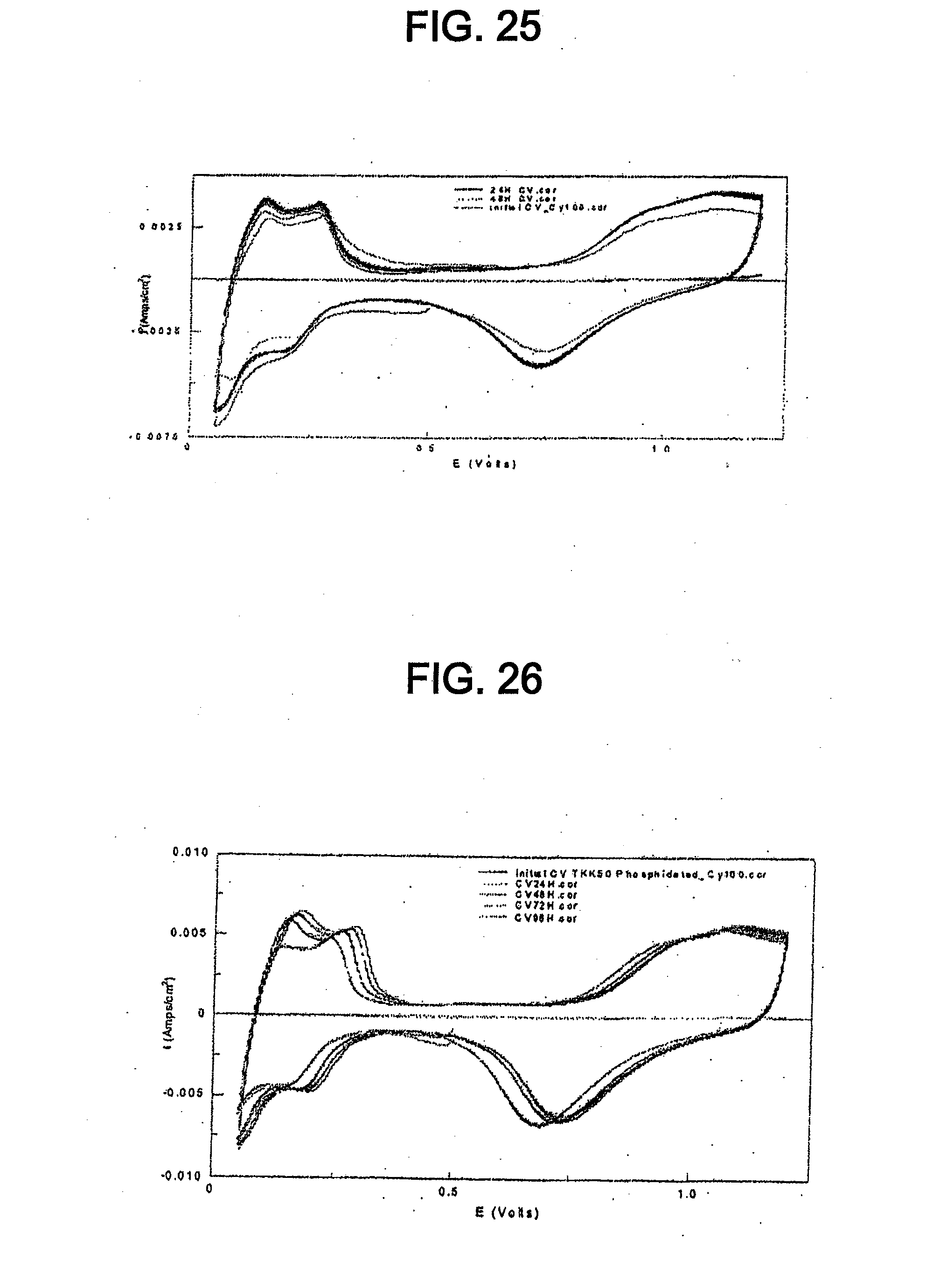
D00013

D00014
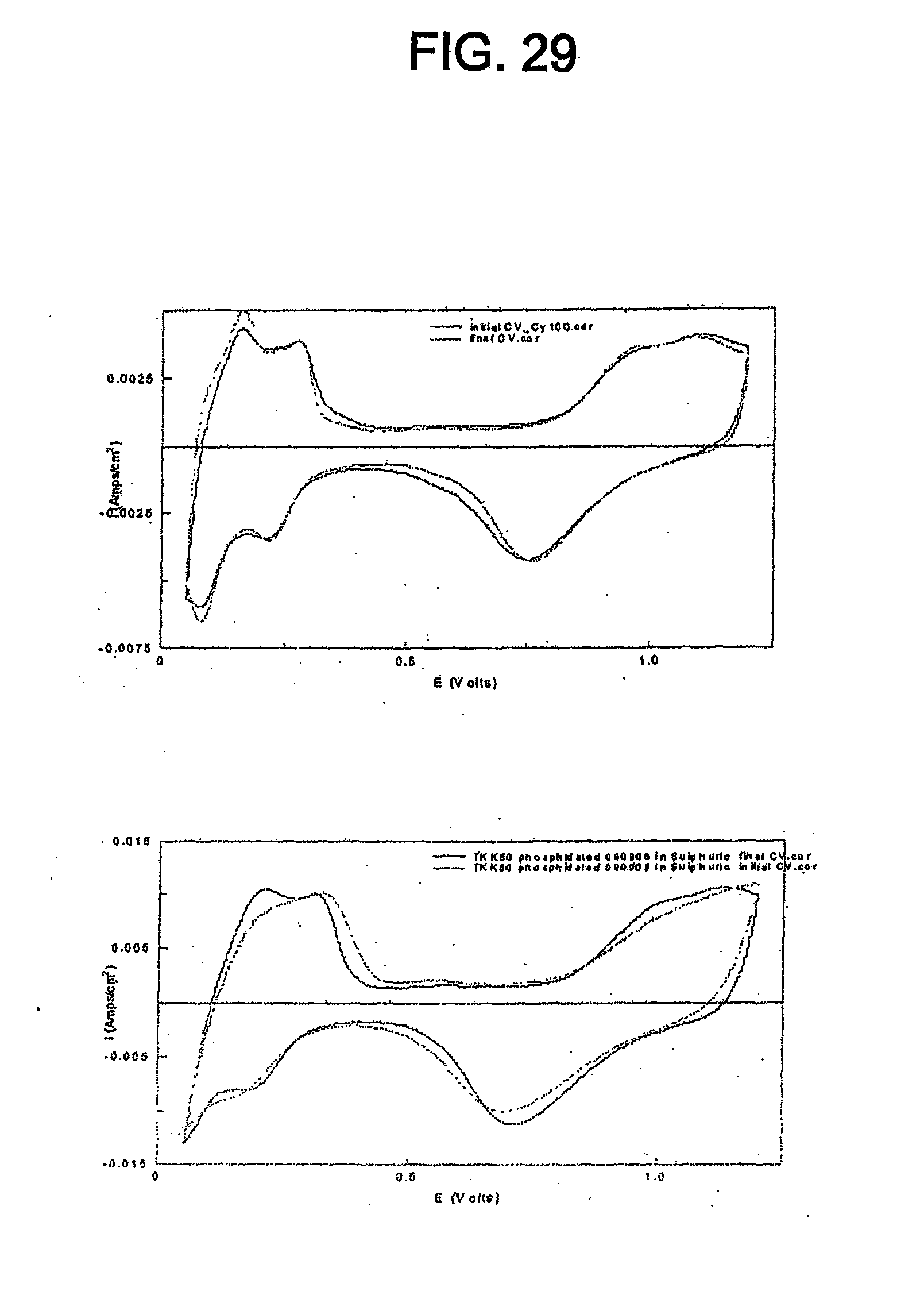
D00015
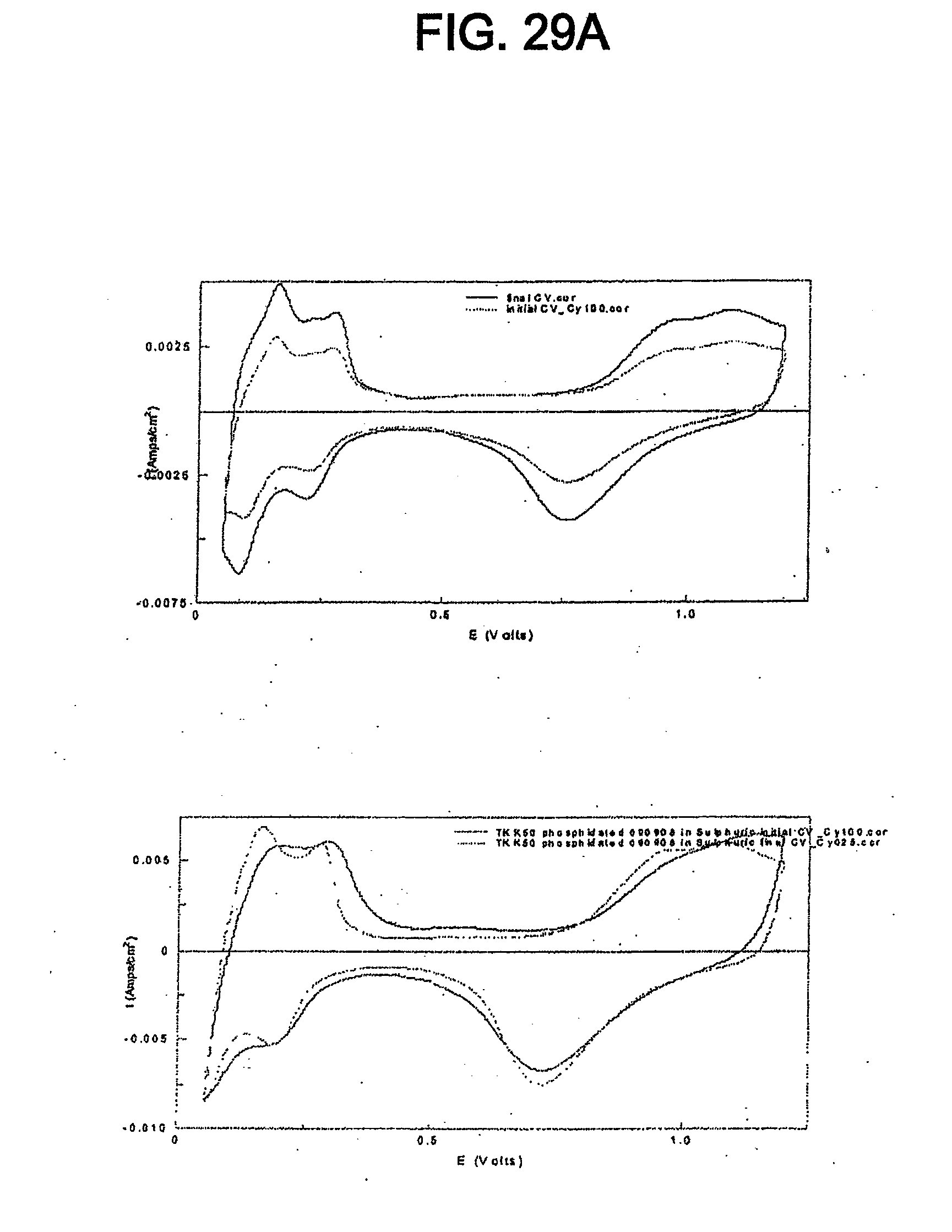
D00016

D00017
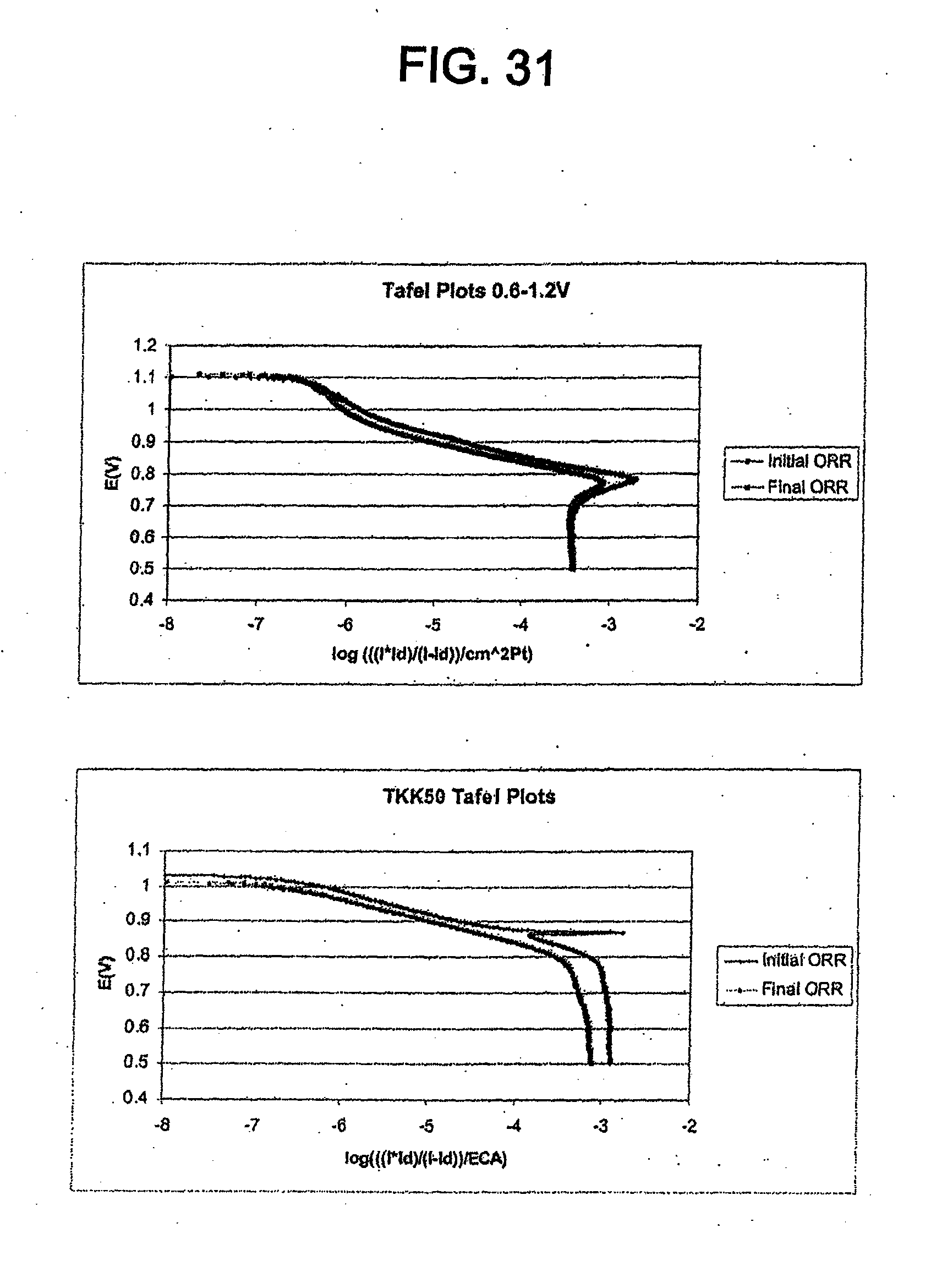
D00018

D00019
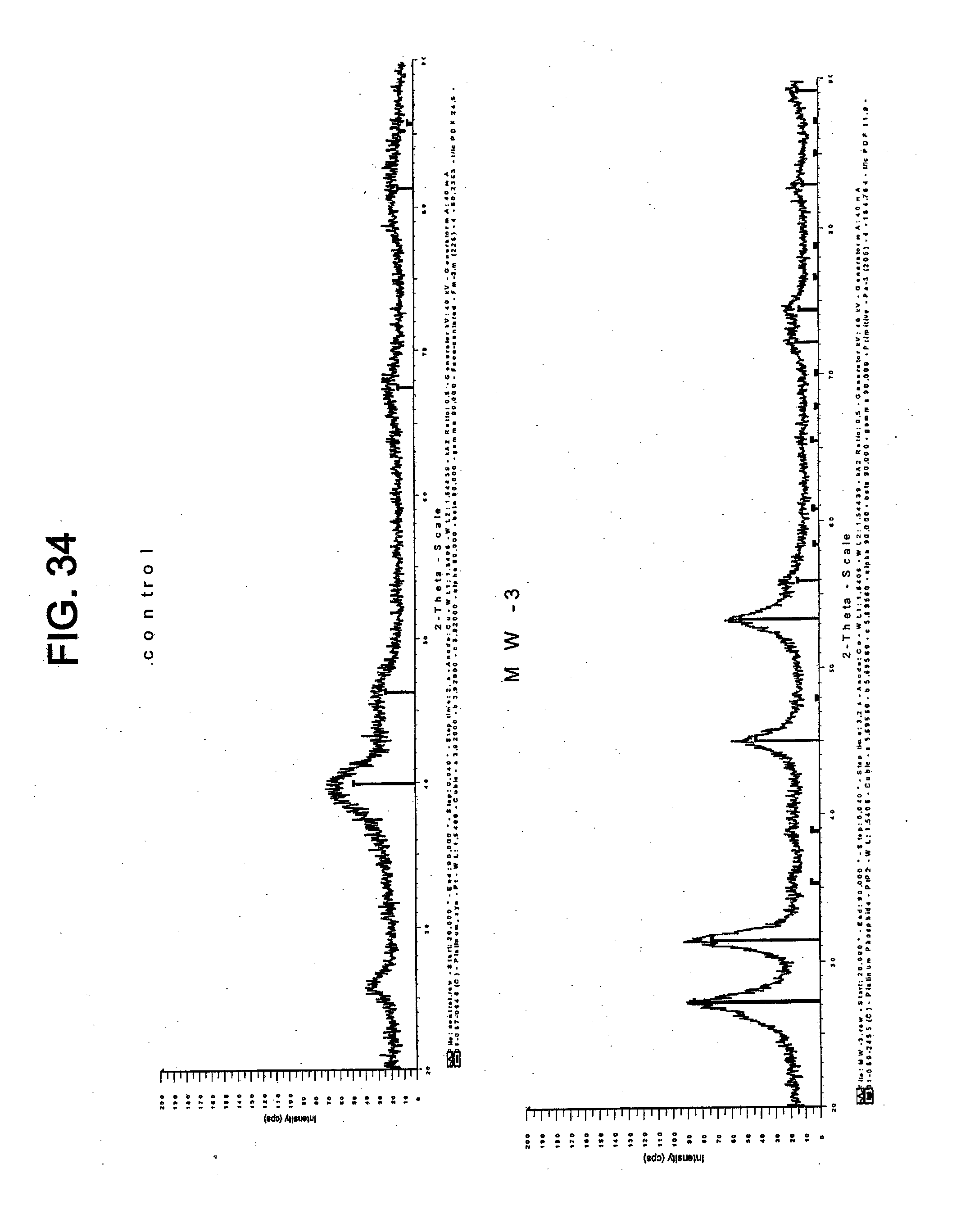
D00020

D00021
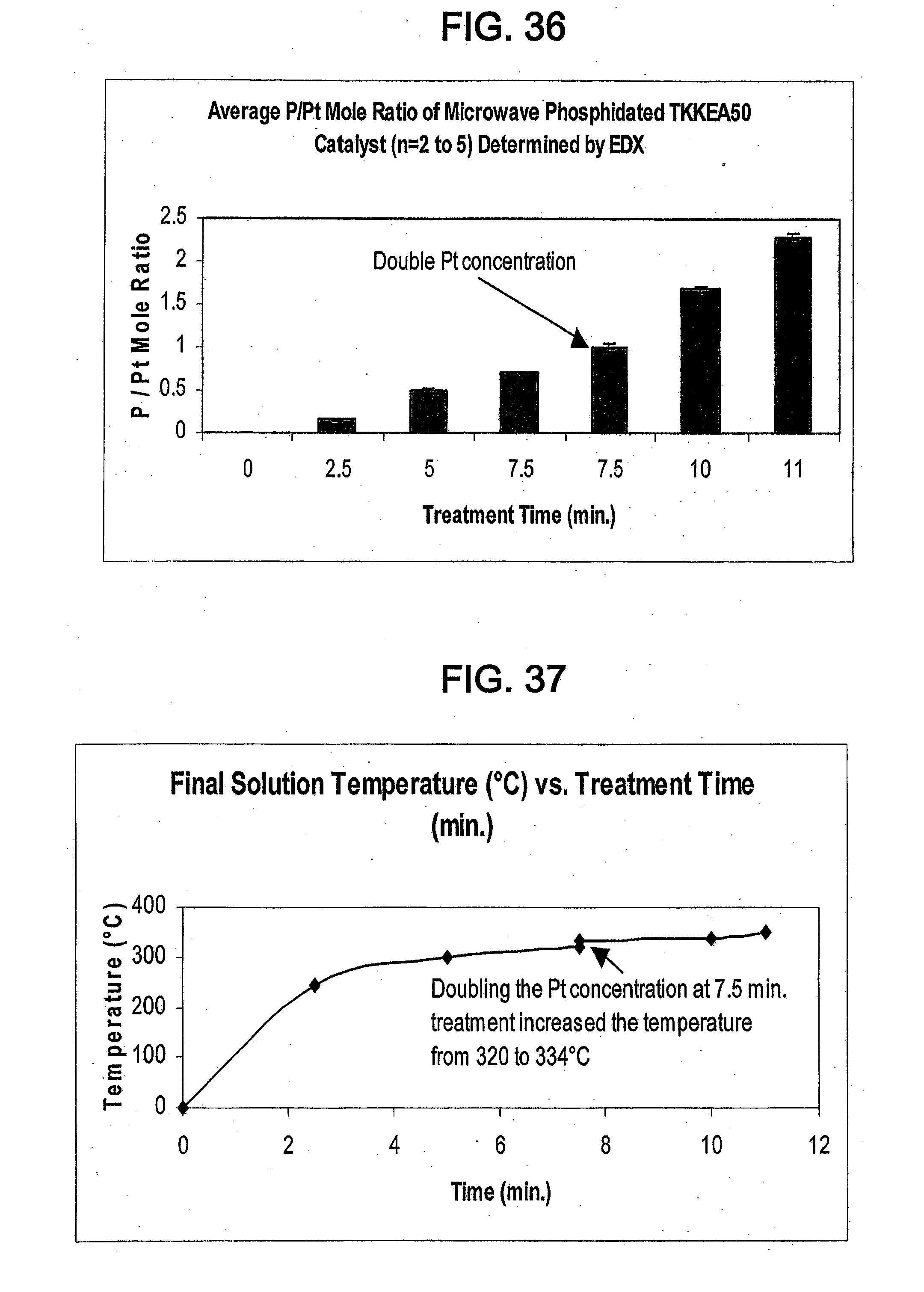
XML
uspto.report is an independent third-party trademark research tool that is not affiliated, endorsed, or sponsored by the United States Patent and Trademark Office (USPTO) or any other governmental organization. The information provided by uspto.report is based on publicly available data at the time of writing and is intended for informational purposes only.
While we strive to provide accurate and up-to-date information, we do not guarantee the accuracy, completeness, reliability, or suitability of the information displayed on this site. The use of this site is at your own risk. Any reliance you place on such information is therefore strictly at your own risk.
All official trademark data, including owner information, should be verified by visiting the official USPTO website at www.uspto.gov. This site is not intended to replace professional legal advice and should not be used as a substitute for consulting with a legal professional who is knowledgeable about trademark law.